Narwhals & Polar Bears: Pond Inlet Trip Report (Jun 19 – 26, 2025)
Day 1: Arrival in Ottawa
As with any adventure, it must start somewhere! For this particular expedition that location would be the Hilton Gardon Inn located just shy of the airport in Ottawa, Ontario. Ottawa’s International Airport acts as a gateway to the Canadian Arctic, being one of the main airport arteries that serves as an access point to the Eastern half of the Great Canadian North, from Cambridge Bay NWT across to Iqaluit NU. Our group thankfully was able to all able to make it to the hotel in time to share an evening meal and do introductions ahead of the next days travel.
Day 2: Arrival in Pond
Our day started before sun-up in order to catch the early morning flight to Iqaluit. On top of being the capital of Nunavut, Iqaluit is a growing community and features the largest population of any of the northern communities. Unfortunately we had a relatively short layover before catching the next plane up to Pond Inlet, so we would be unable to explore the town until our return trip brought us back through for a slightly longer stay. Our flight to Pond was on a smaller 70 seat twin propeller airplane, and we had some great first views of the town as we broke below the cloud cover for landing.
We were greeted at the Airport by the one and only Sheatie, our main Inuit guide who’s wisdom and expertise we were to reply upon for our foray out onto the sea ice. Along with Sheatie we met his daughter Geanie, and another fellow guide Elijah who was to be our camp cook for the trip. They helped us with our luggage and ushered us down to the hotel. Most of our afternoon was taken up by arriving and getting situated and signed into the hotel, but after supper we stepped out for a walk around the town to take in the local scenery. There is a very nice covered viewing platform uphill a short walk from the hotel that gives great views of the town and the ocean inlet, with mountains backing either side giving a breathtaking view, especially as they were still quite covered in snow with a few glaciers peeking out between the peaks as well. The hillside around us was just starting to show the beauty of the arctic summer with wildflowers starting to poke up offering their brilliant colors which contrasted with the darker mosses rock that make up the majority of the landscape.
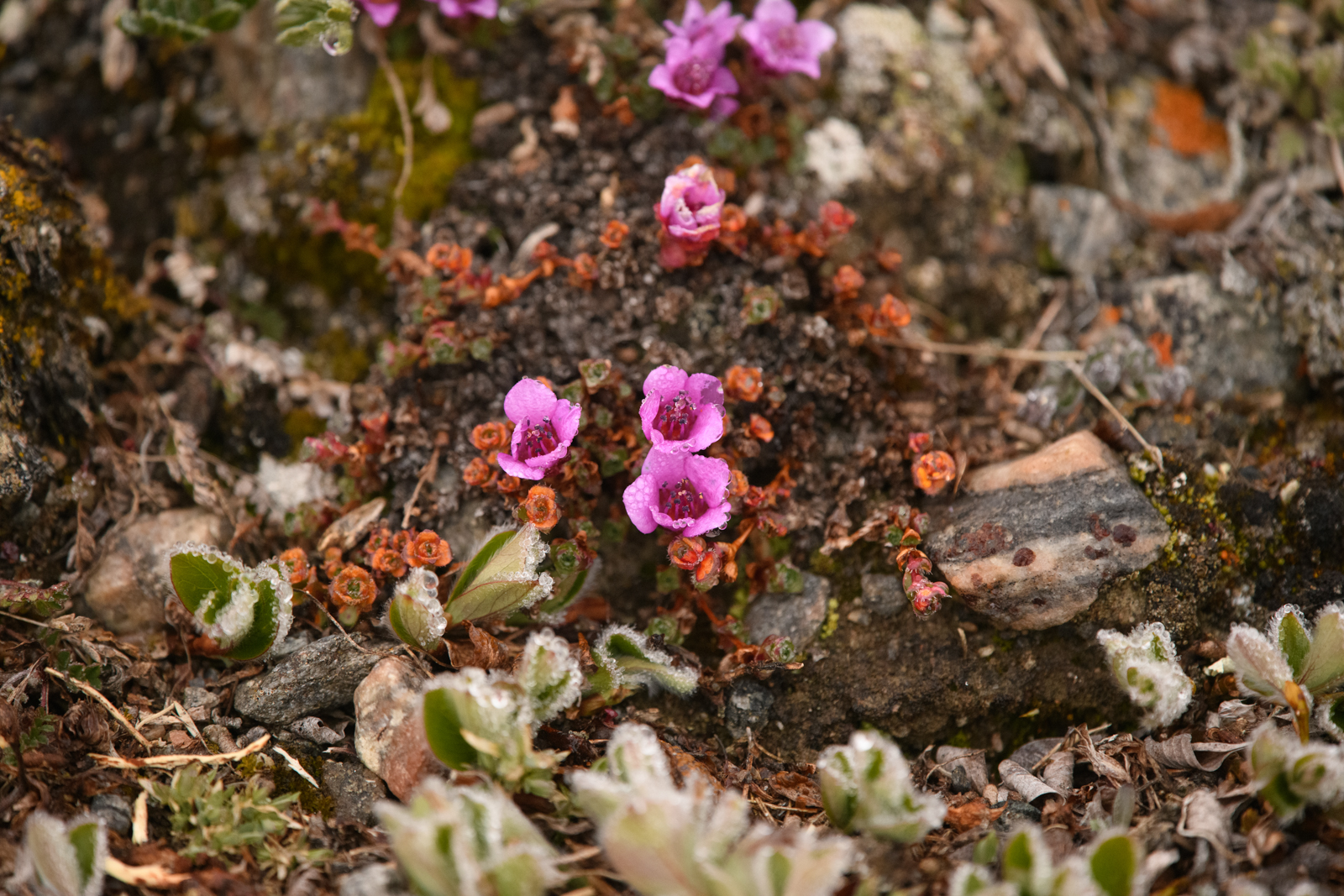
Purple Saxifrage © Daniel Giesbrecht
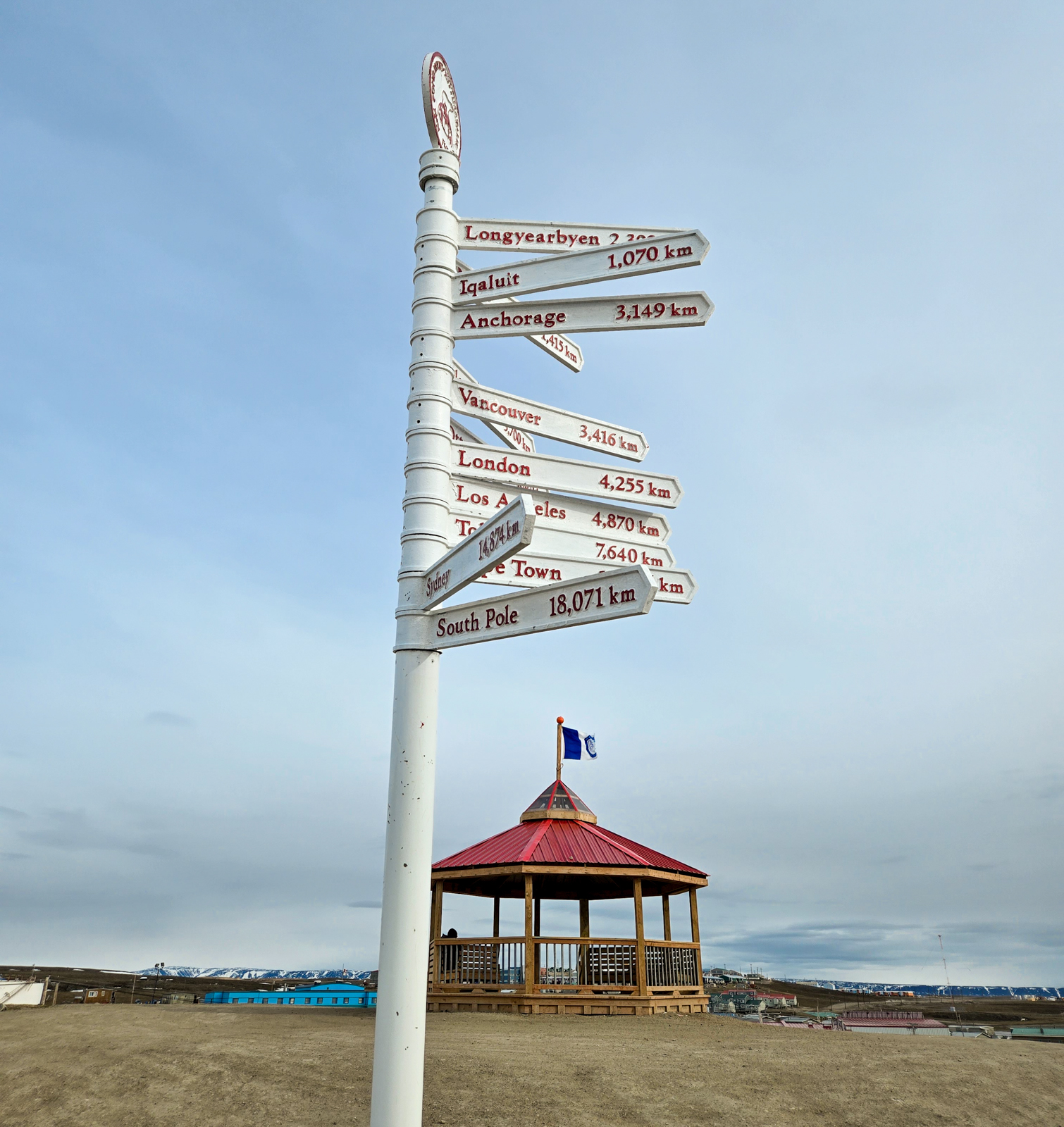
Pond Inlet viewing platform © Christine Bentley
Day 3: Around town and trip to Camp
After our tasty warm breakfast at the hotel, as a group we opted to stretch our legs ahead of our afternoon trip and took to the streets of Pond Inlet.
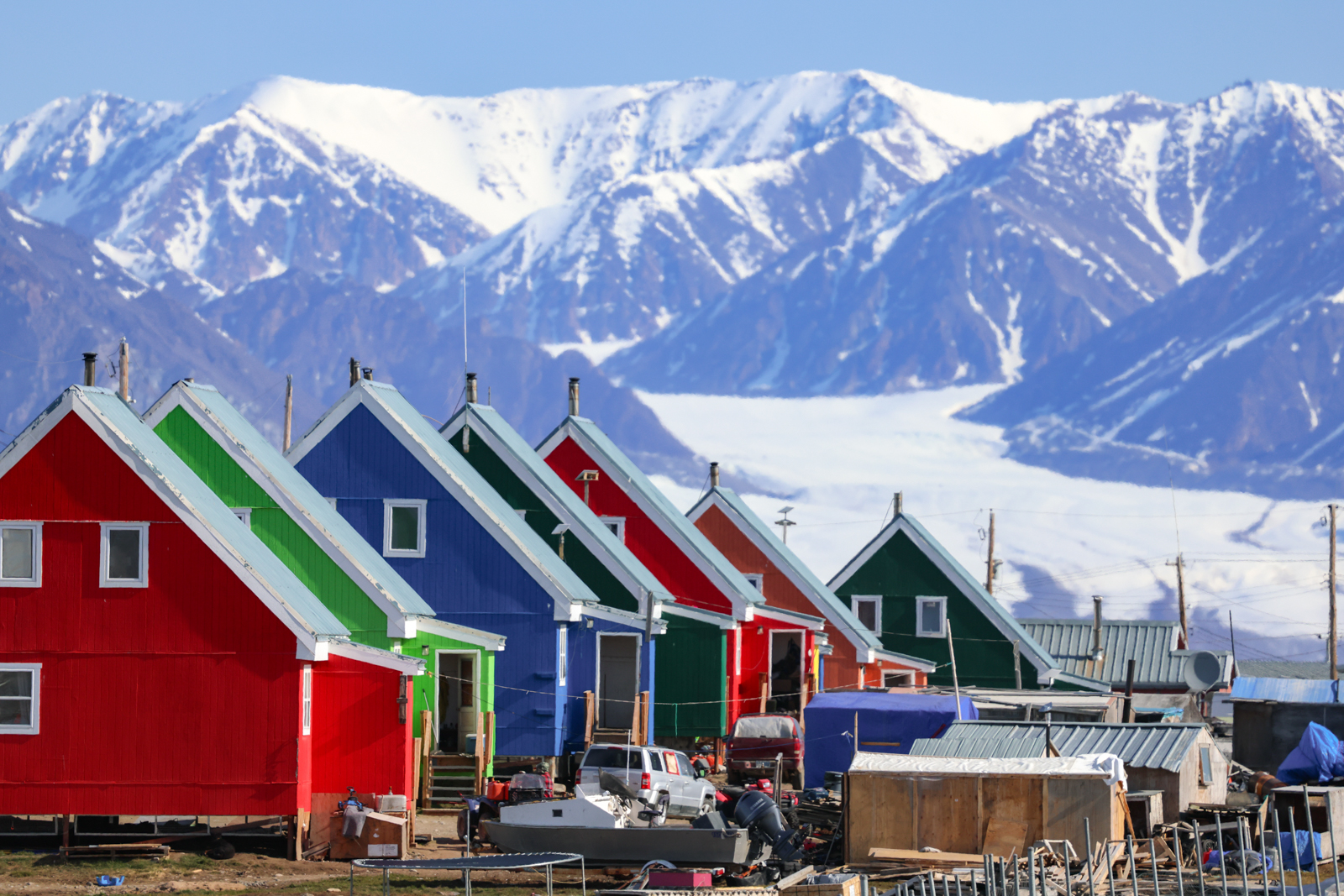
Colourful houses in Pond Inlet © Deping Wei
We walked the length of the town, alongside the airstrip southwards and down the small bridge that crosses Salmon Creek. Along the walk we had some Horned Larks hopping by, and we happened upon a pair of Red-throated Loons together on one of the larger ponds by the roadside.
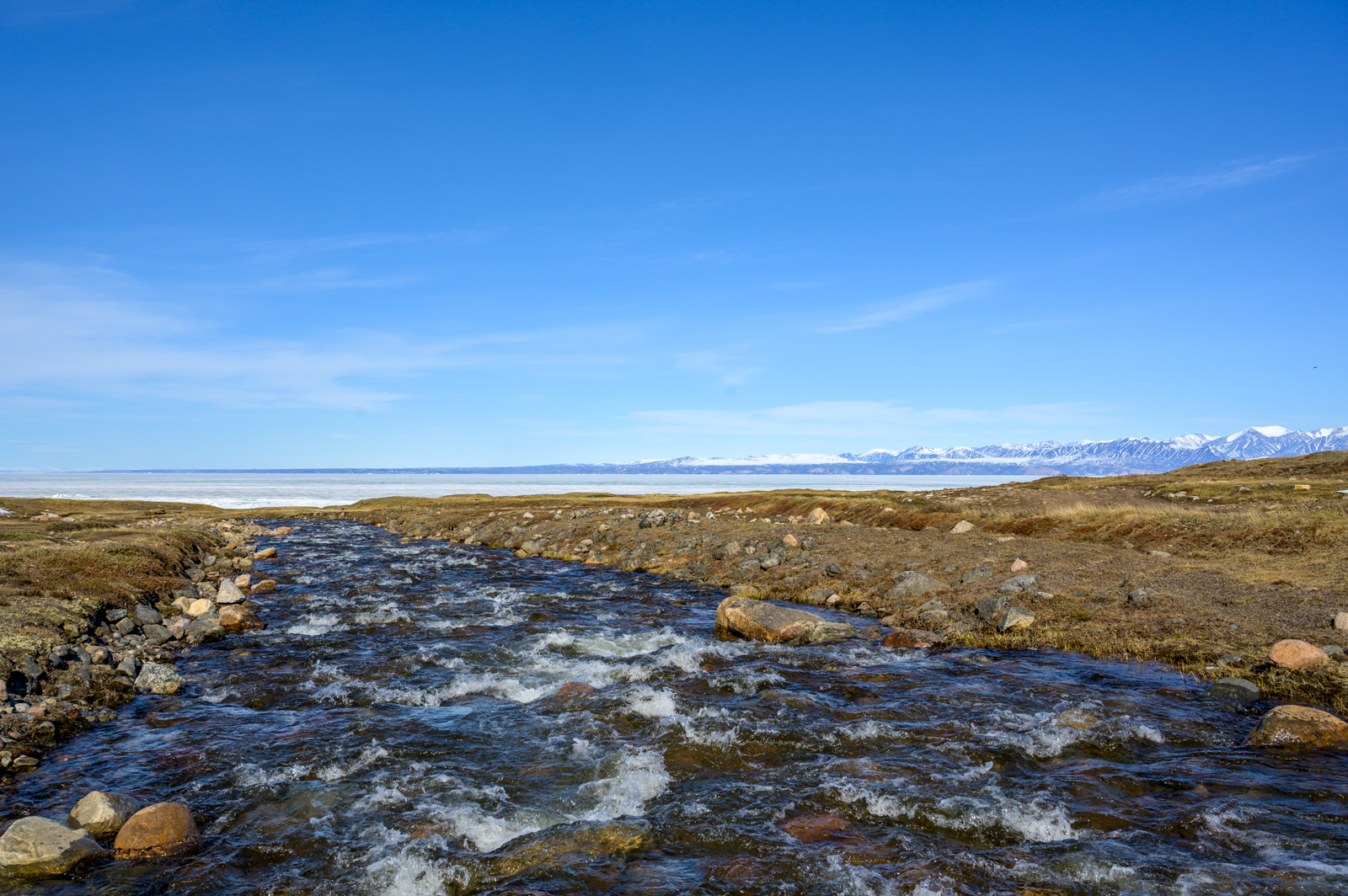
Salmon Creek © Daniel Giesbrecht
After lunch Sheatie and company arrived to ferry us down to the Komatiks (Qamutiik). As the snow begins to melt in the spring, the majority of the townsfolk keep their snow machines and Komatiks just offshore on the ice near one ramps that double as a boat launch during the summer months. We carefully picked our way through the various snowmobiles and across the growing splits and meltwater ponds in the ice, and loaded up for the 4 hour journey ahead.
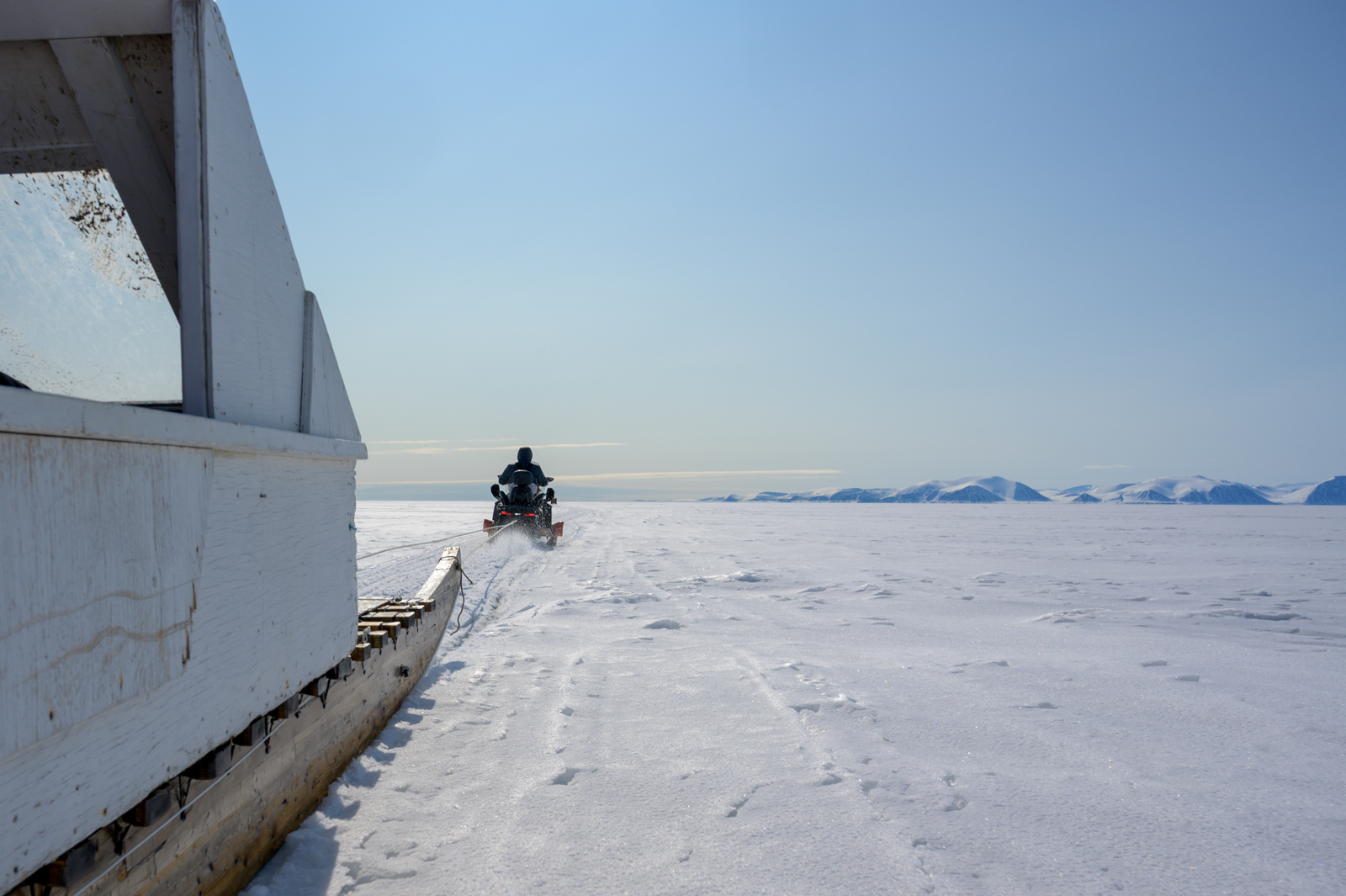
Komatik (Qamutiik) on ice © Daniel Giesbrecht
The trip out to the Floe Edge can be though of as three stages; Along the southern shoreline along Baffin Island, across the ice, and along the southern shore of Bylott Island. The first part of the journey is across the larger ‘bay’ that is formed around the community of Pond Inlet, where we continued along the shore of Baffin Island (which forms the main body of land around Pond) towards the much smaller Beloeil Island that acts as a halfway point. The island itself seems to have been rent violently from the surrounding cliffside and forms an unmistakable landmark as it pokes upright along the shoreline.
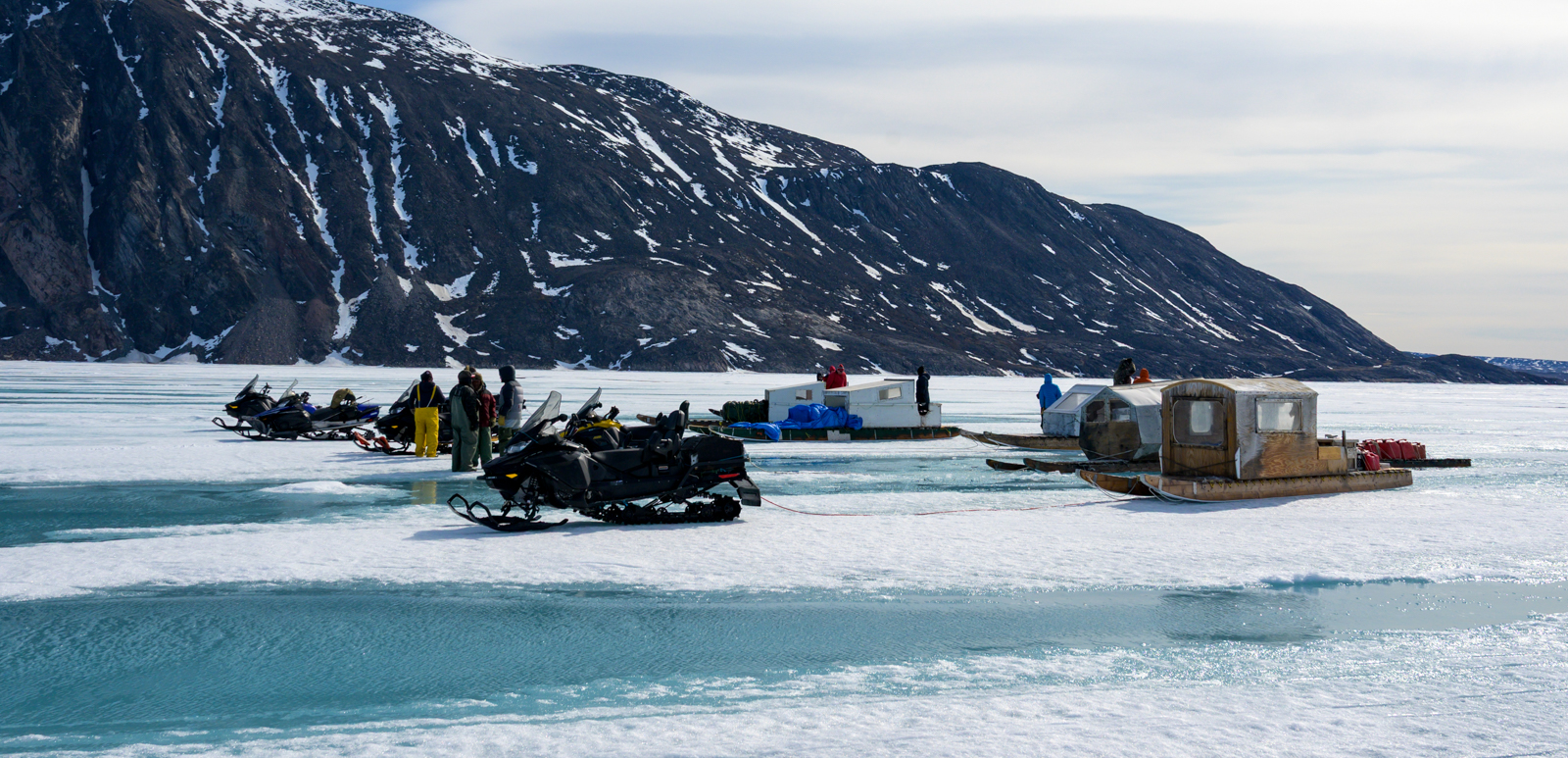
Taking a break near Beloeil Island © Daniel Giesbrecht
From the island we continued along the shore, until we came to the proper lead in the ice that would take us North across the inlet. Every year the local community maps out the large cracks in the ice (called leads) which remain somewhat consistent throughout the winter and spring. For experienced locals such as Sheatie, they act as a map guiding them in their journey across the ice. When we came to the appropriate lead Sheatie, who was in the lead snowmobile, took us Northwards towards Bylott. This was made even more impressive since halfway through our journey the sunshine which we had enjoyed in the open calm air of the bay, had turned to thick fog as we drew closer to the Floe Edge and the open ocean. Sure enough, Sheatie was able to take us directly to camp as if lead by an invisible string guiding him along. Once there we all pitched in to unload, assign tents and get all of our supplies in order. After a nice warm meal, we all made our way to our tents and tucked in for our first night on the ice.
Day 4: First full day at Floe Edge
Upon waking we were greeted by sunshine and open skies, and were finally able to take in the wonderful views around us. The Mountains on either side of us glowed with their snowy peaks, with the more gradual slopes just to the north of us on Bylott island being already bare showing willow buds and a smattering of purple saxifrage.
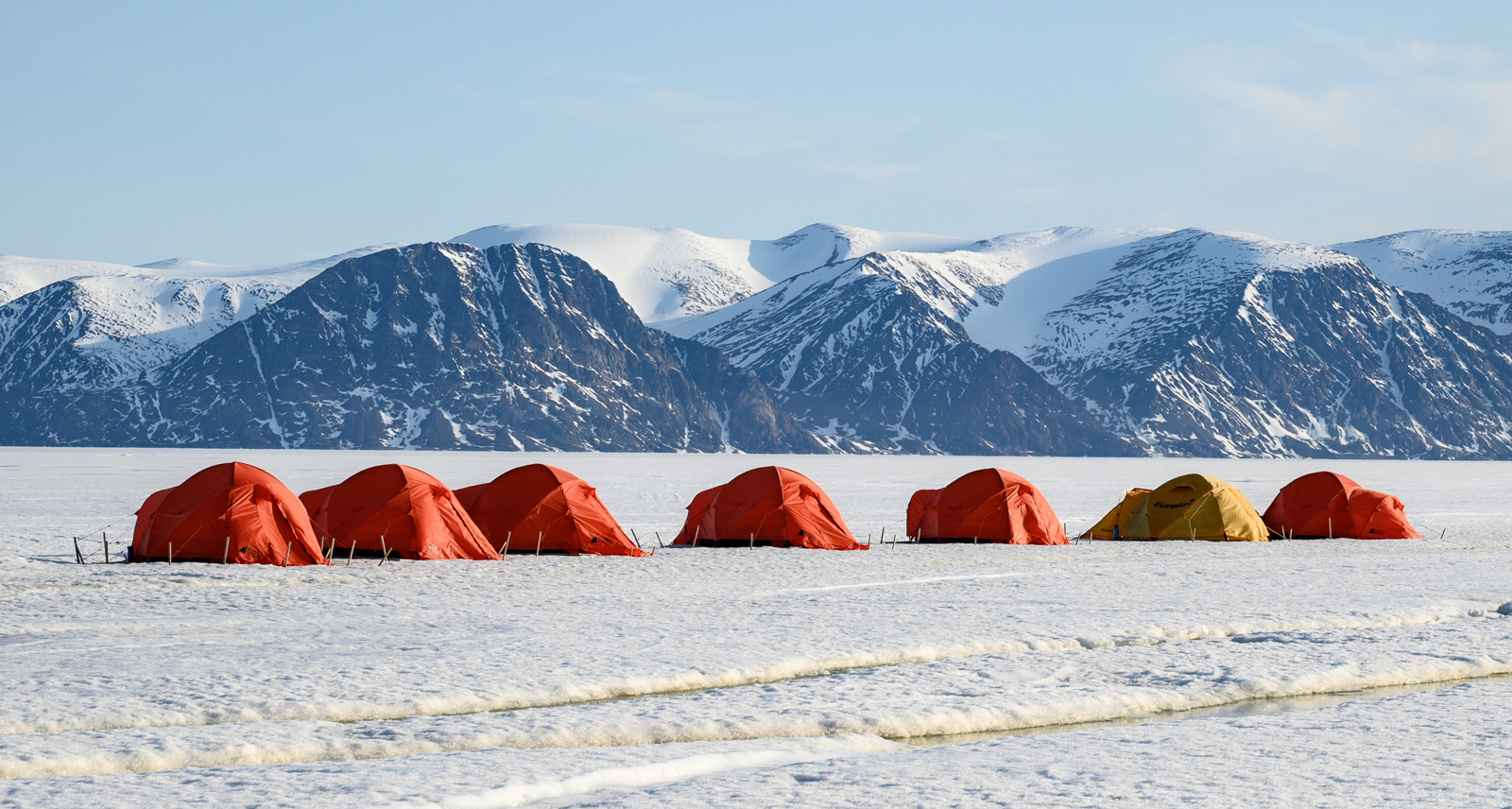
Our camp © Daniel Giesbrecht
After a hearty warm meal (and plenty of coffee) we packed our day bags and hopped back into the komatik and headed back onto the final stretch of ice that would take us to the waters edge. Over the previous few days, prevailing Northeastern winds had piled up a large amount of broken ice along the Floe Edge, so we headed just shy of halfway down the ice edge to where there was more unobstructed open water.
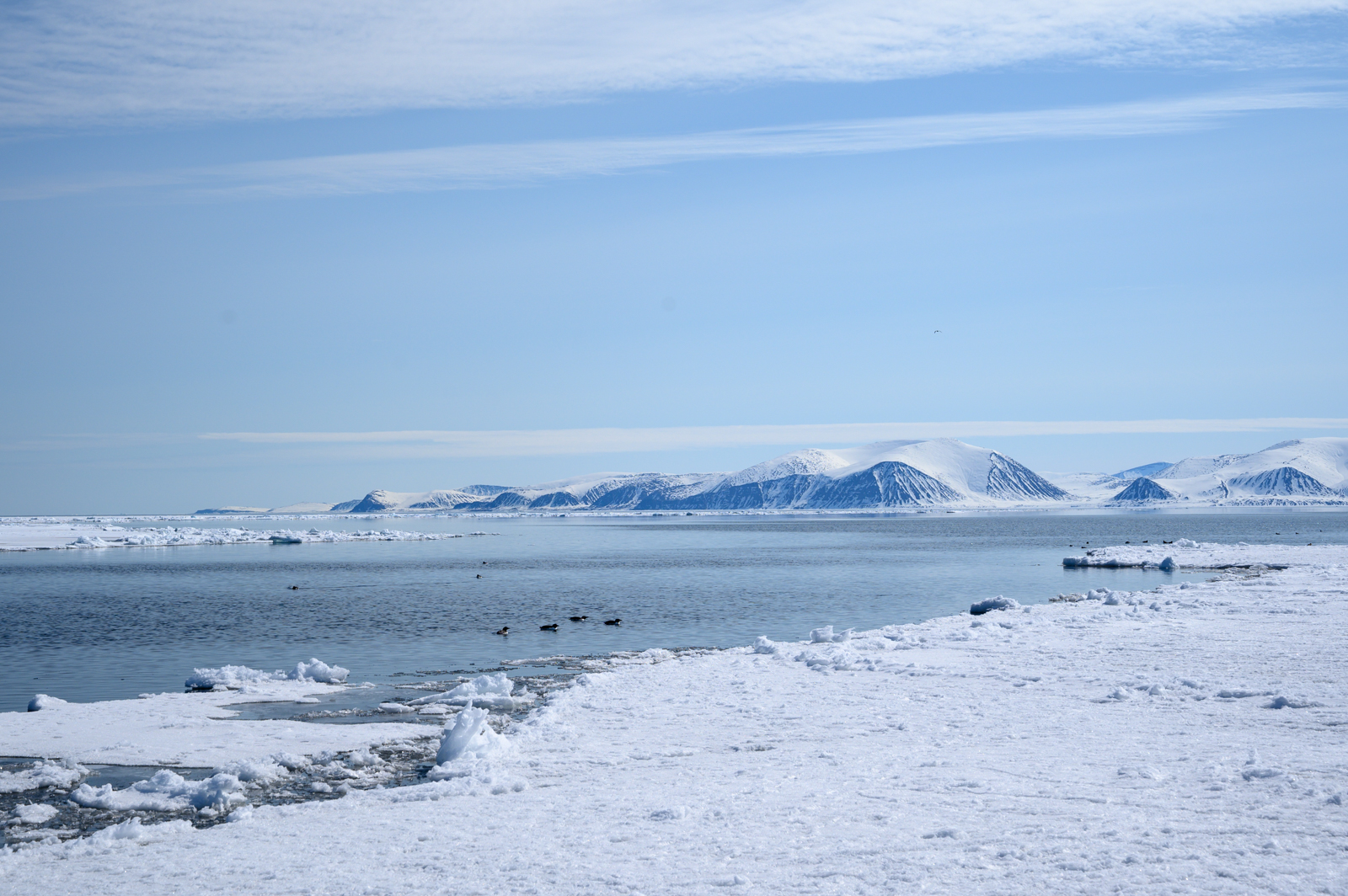
Floe edge © Daniel Giesbrecht
Within 15 minutes of arriving, and having barely set up our temporary camp, we spotted a Polar Bear out on one of the many large flotillas of ice. It was around 300-400 meters away, but everyone got good looks at it through the scope as it made its way Northwards away from where we were situated.
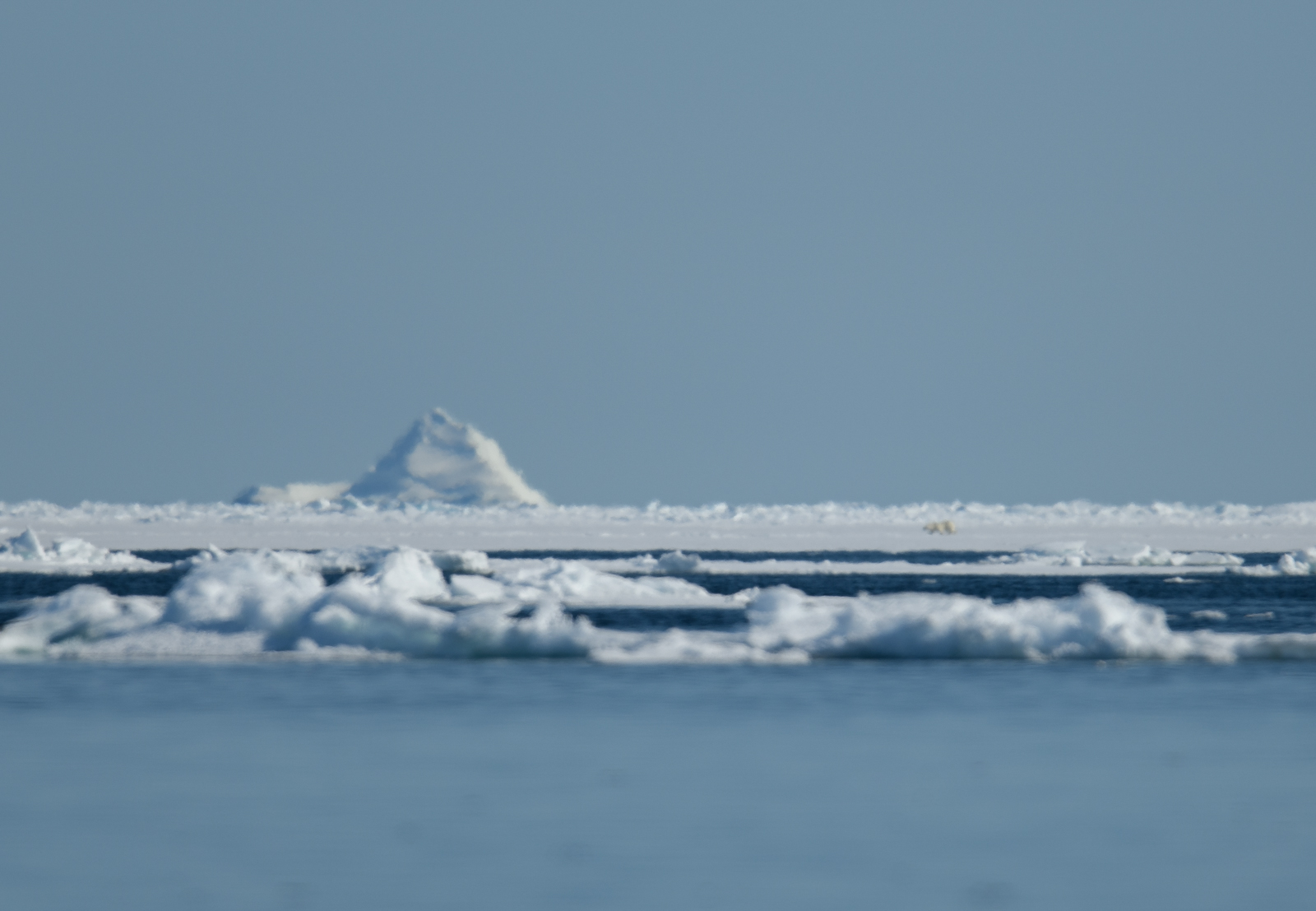
Distant Polar Bear © Daniel Giesbrecht
The waters edge was teeming with bird life, with groups of Thick-billed Murres flying past and landing around us on the water where they would dive for food. Northern Fulmars were constantly flying past, dipping almost impossibly close to the surface of water on expert wings. Several groups of Eiders, both King and Common, were seen flying a bit further out throughout the day, and all 3 Jaeger species were spotted throughout the afternoon, looking for some poor unsuspecting victim from which to harass for their next meal. Several Ringed Seals could also be seen swimming about, with the closest seal to us at any given time always being designated as ‘Sam the Seal’.
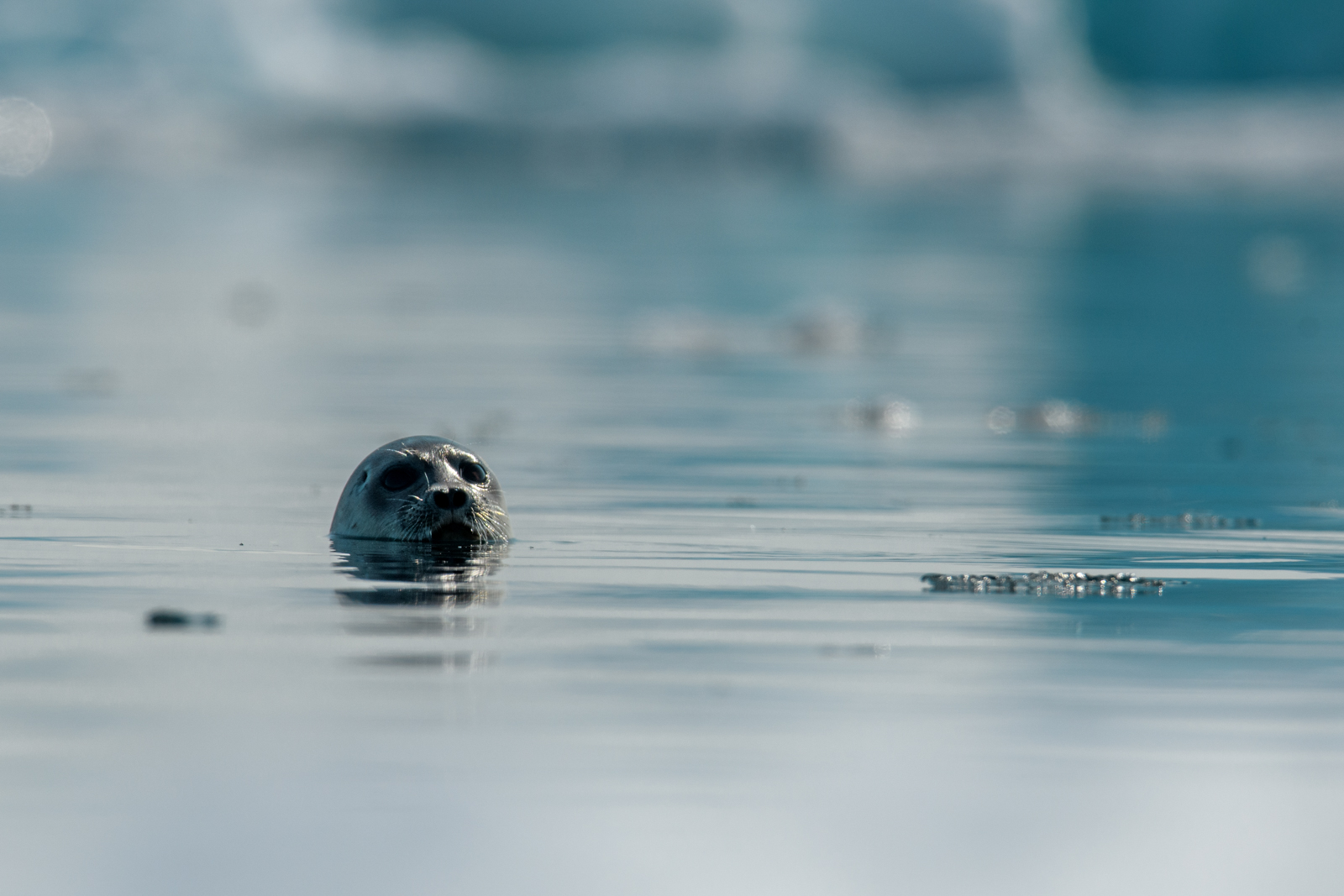
Sam spyhopping © Daniel Giesbrecht
As we were scanning the water and watching the Murres bob up and down in the gentle swells, a rather powerful yet simultaneously gentle noise was heard just to the north of us. This turned out to be the exhale of a Bowhead whale, which swam right up along the ice towards us. After a few more blows it dove deep down into the water not 80 feet in front of us! It was so close to the ice that it did not fluke, and simply disappeared, slipping into the deep dark waters and was not seen again.
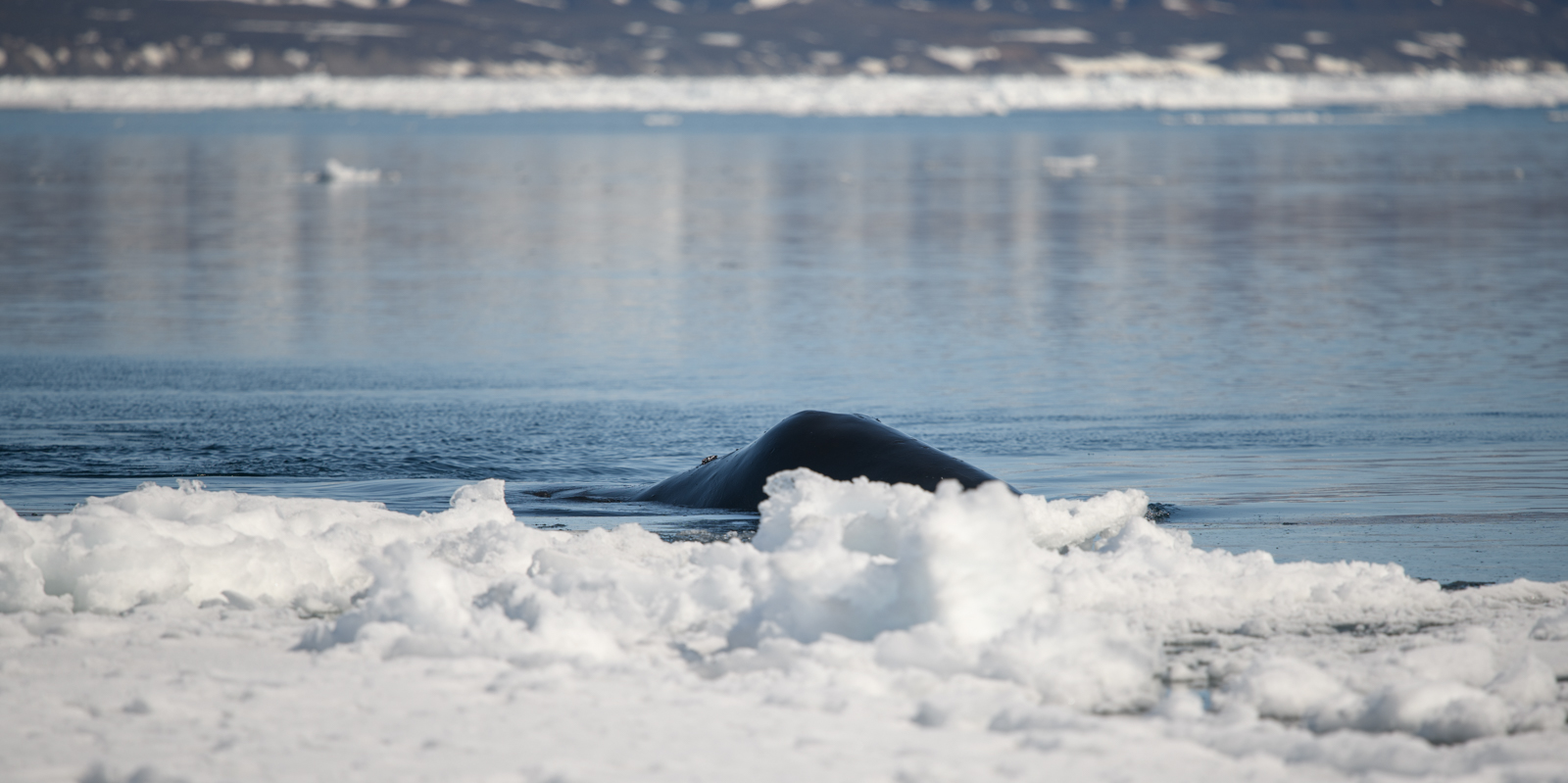
Bowhead whale © Daniel Giesbrecht
Needless to say everyone was quite excited at having seen 2 of our ‘target’ species withing a relatively short span of time, but it would not end there! About halfway through the afternoon a Narwhale was spotted floating about 300 meters out in the water, just in front of a large patch of ice. We would spend the next hour and a half watching it in between foraging dives for food. We even figured out its dive times to average around 9 minutes, so we had an ongoing stopwatch to know when it was about to surface again. All in all the first full day out on the Floe Edge was a day to remember!
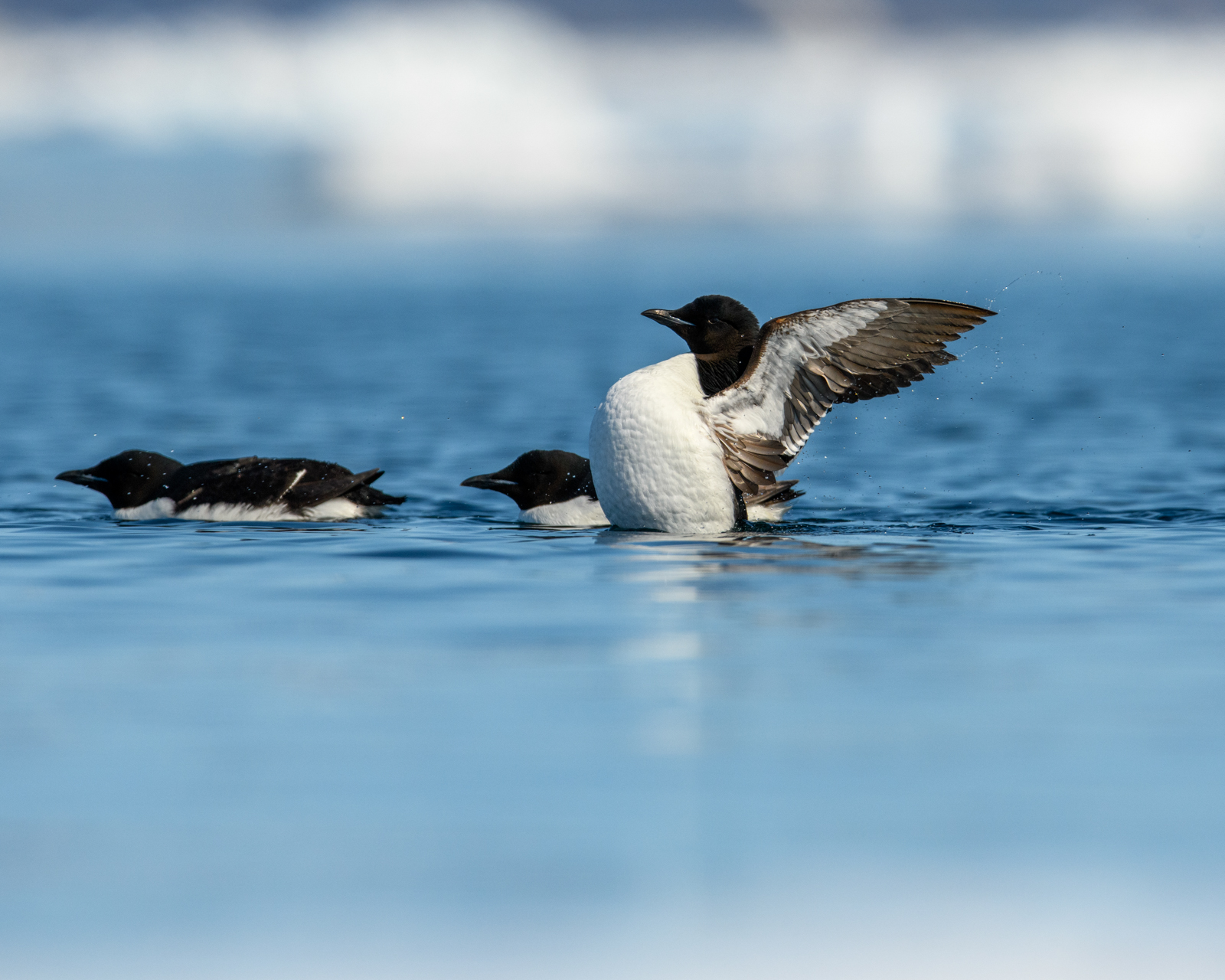
Thick-billed Murres © Daniel Giesbrecht
Day 5: 2nd Full Day, Camp Stayed
In contrast to the previous day, fog laid thick and heavy over the landscape as we began to poke our heads our of our tents in the morning. Visibility was quite poor at under 200ft, and we decided against heading out as there was not much point as we wouldn’t see much at all, in addition to the safety concerns associated with extra low visibility. Sheatie went off to do a scouting trip late morning, and found that the conditions did not change further along towards the waters edge, and we ended up staying in camp all day swapping stories and sipping on hot drinks. Towards the evening some Rock Ptarmigan began calling up on the hillside just outside of our camp, and a few of us clambered up amongst the loose rocks and mosses and managed to get some good looks at a breeding plumaged female with a still-white male.
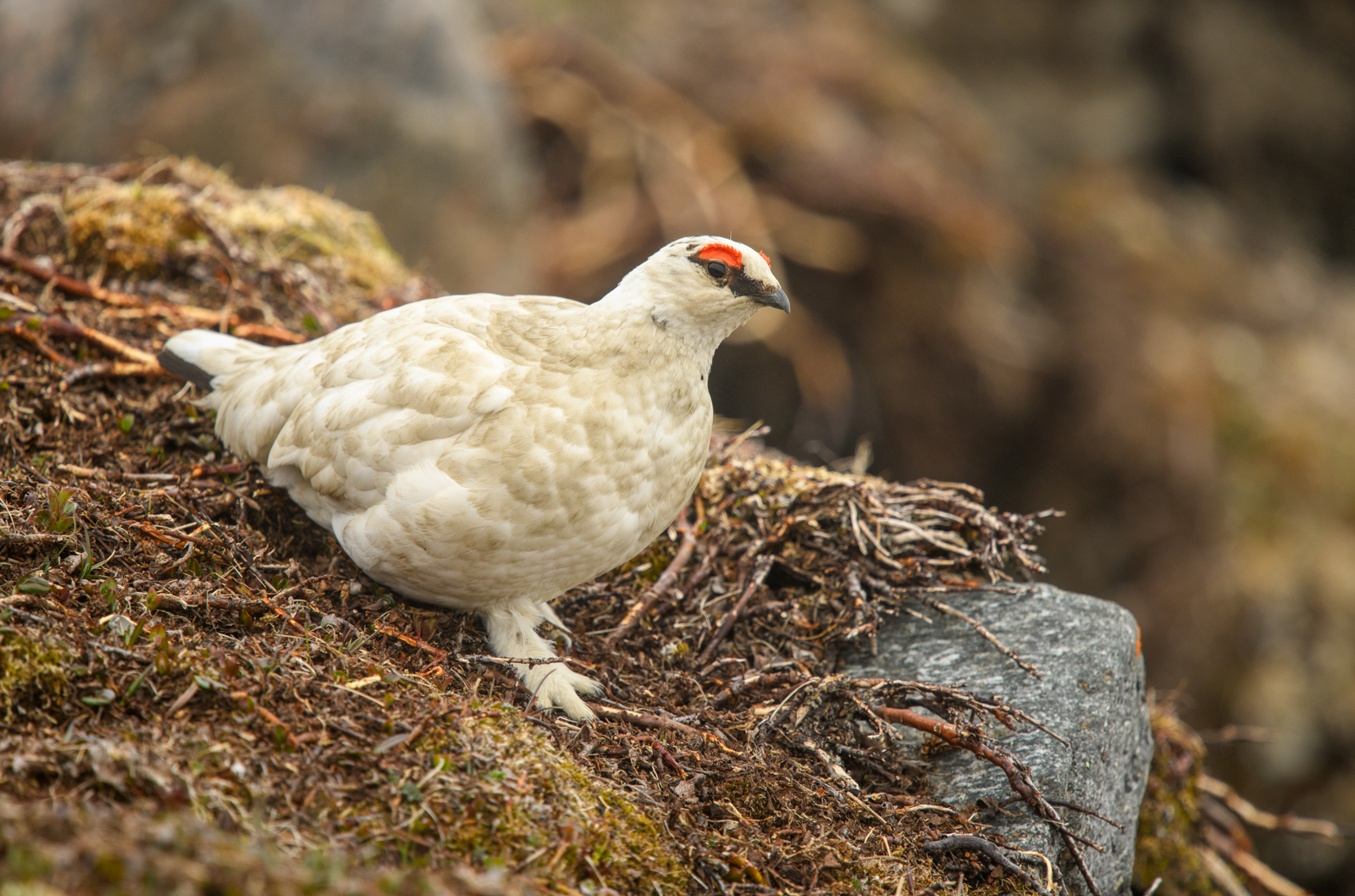
Rock Ptarmigan © Daniel Giesbrecht
Day 6: 3rd Full Day; Mist at the Water’s Edge
Upon waking we were once again greeted to the same gray wall of fog, and made a point to enjoy a slow breakfast and swap stories once again. By late morning it was showing signs of letting up slightly, and we decided to make a go of it. Sheatie once again made a show of his years of expertise by guiding us through the fog right down to just past where we had been stationed 2 days previous.
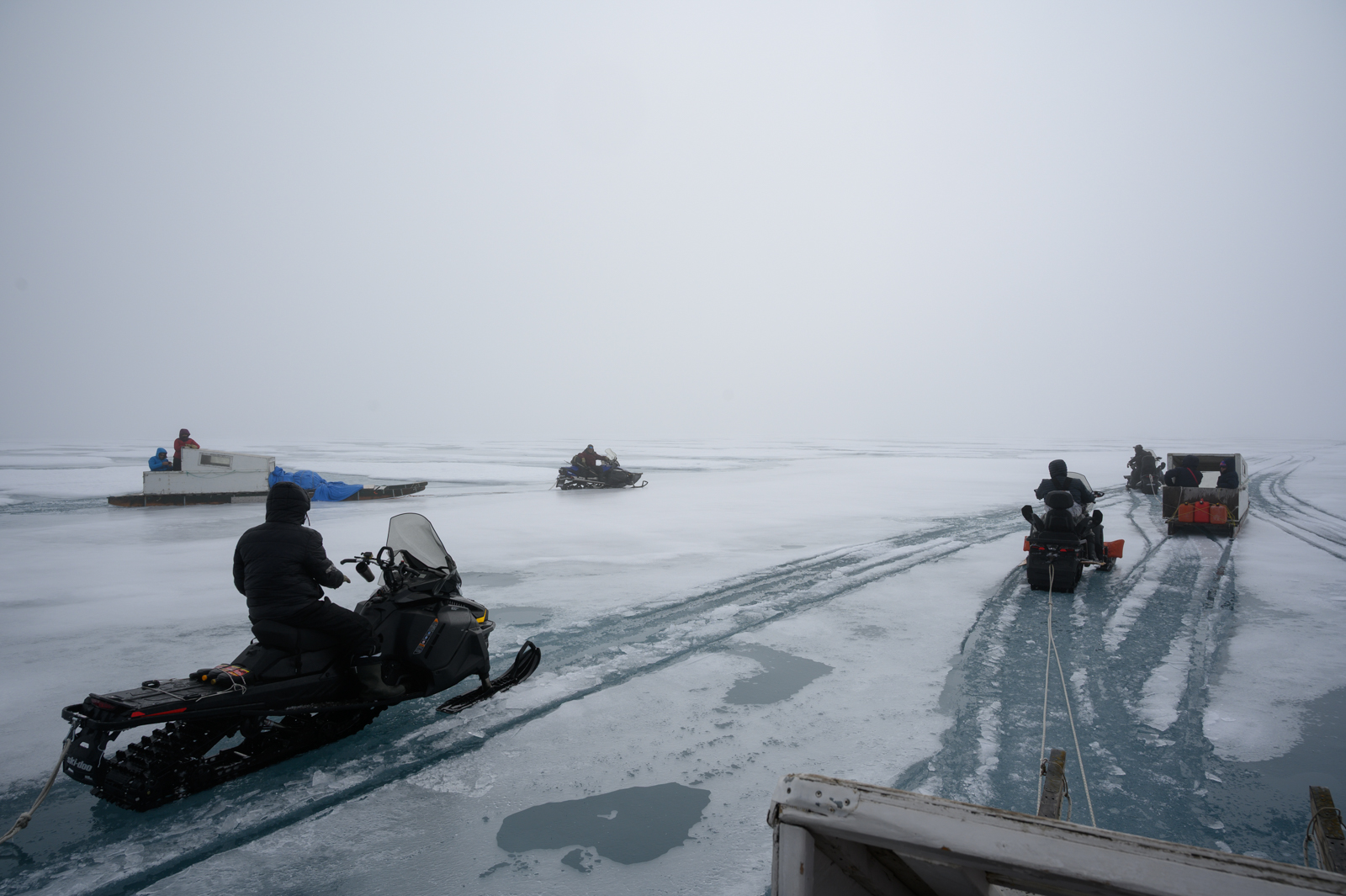
Foggy stop © Daniel Giesbrecht
The fog continued to blow around throughout the day, but did nothing to deter our steadfast attention to the water and what secrets lay just beyond its shimmering vale.
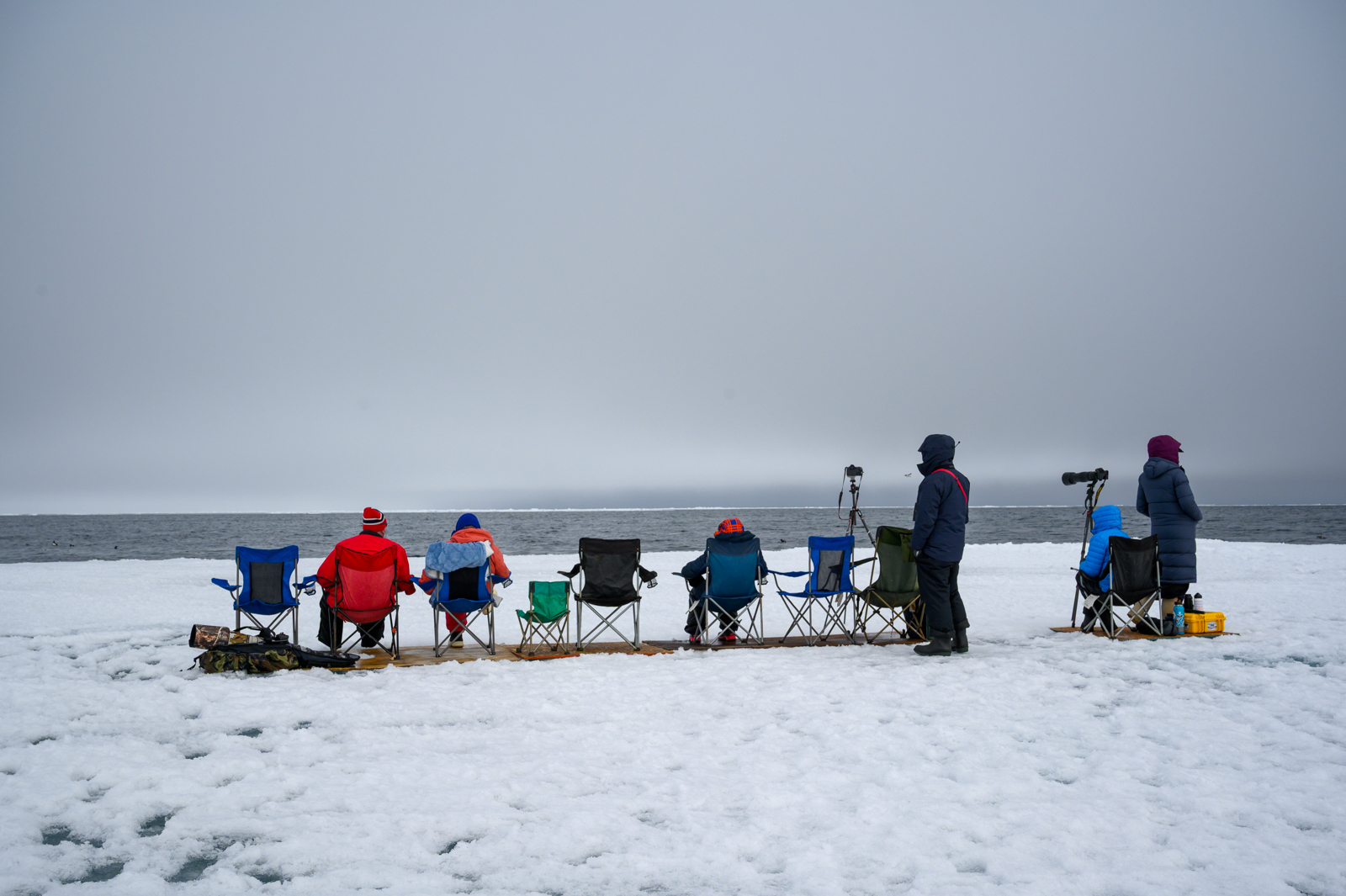
Watching in the fog © Daniel Giesbrecht
The Murres were still around in large numbers, and seemed to be even more tame towards us in the low visibility and would swim right up to us just before diving below the ice. In addition several small groups of Black Guillemots were coming and going as well. Their high pitch calls barely audible above the breeze was testament to their nickname ‘fog fairies’. A small group of Dovekis also made an appearance, and landed within 100m of where we were stationed, and spent the better part of an hour feeding amongst the contrastingly large Murres.
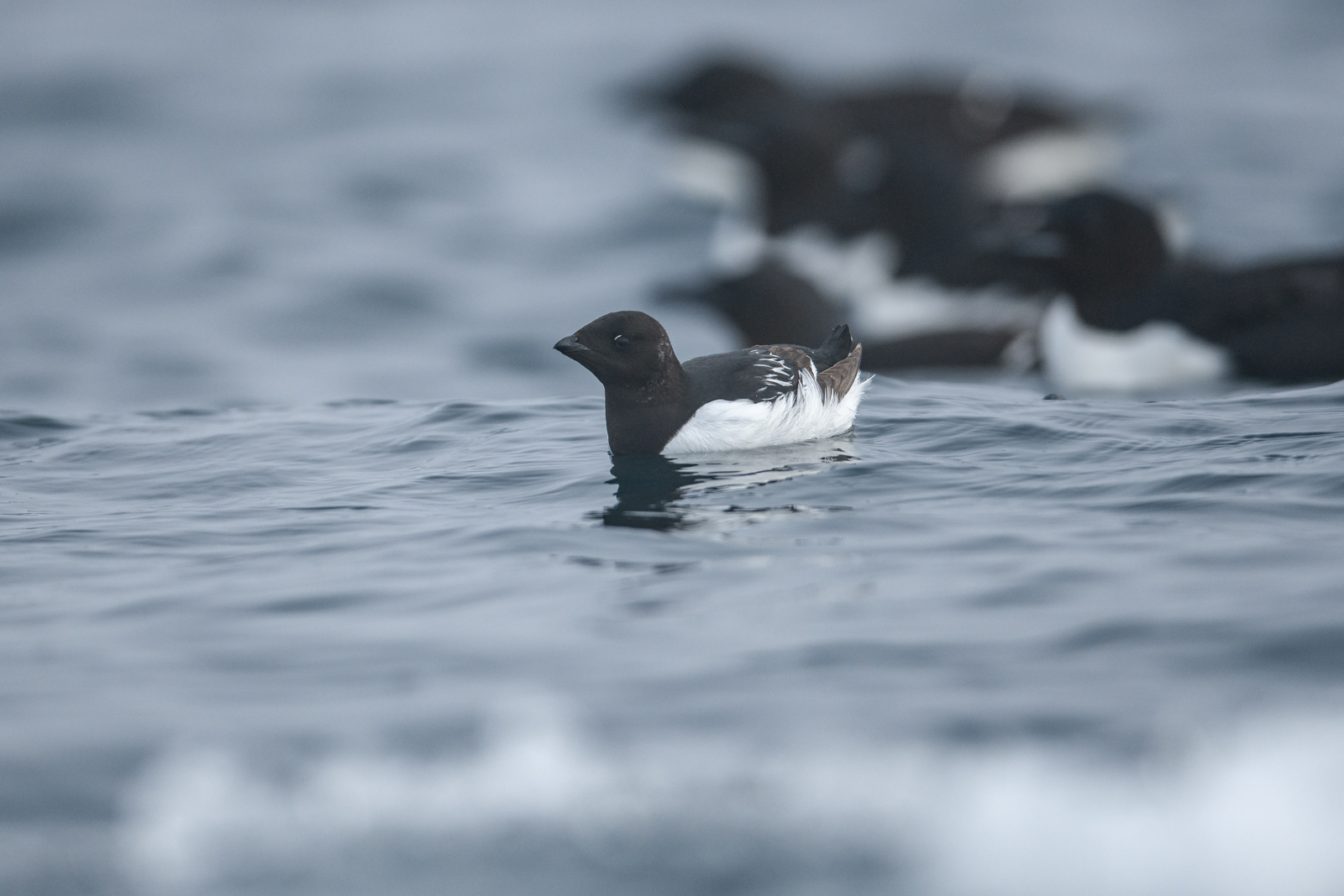
Dovekie © Daniel Giesbrecht
Northern Fulmars had come to be a common sight, typically flying past with efficient sharp wingbeats typical of seasoned seabirds.
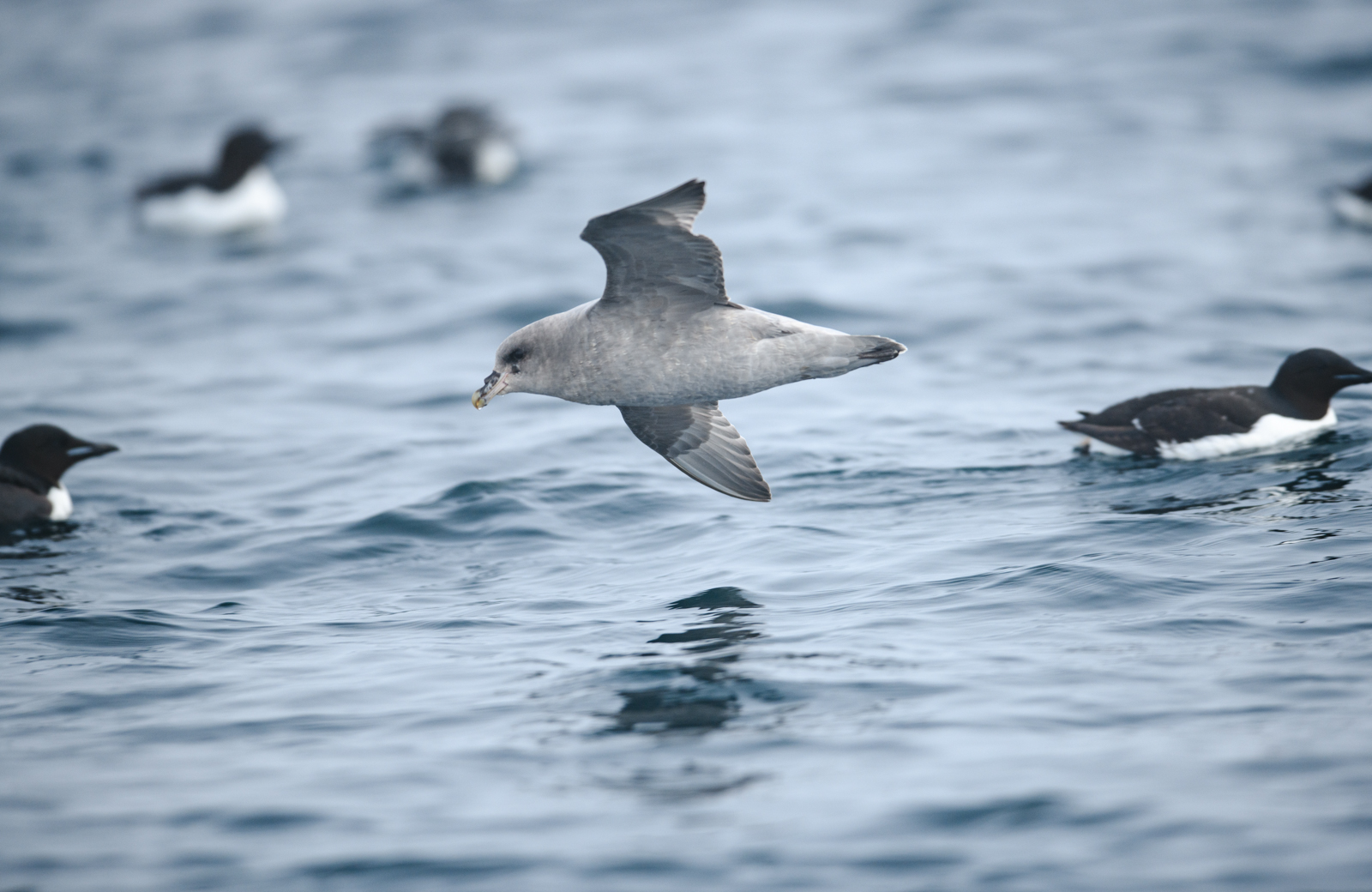
Northern Fulmar © Daniel Giesbrecht
A few hours into our patient plight, a keen ear picked up the sound of a whale blow. We all looked up and sure enough, through the fog materialized a singular Narwhale headed straight for us. It played out like a scene from a storybook, with the whale surfacing several times in a straight line right at us, with its final dive and subsequent fluke not 100ft offshore.
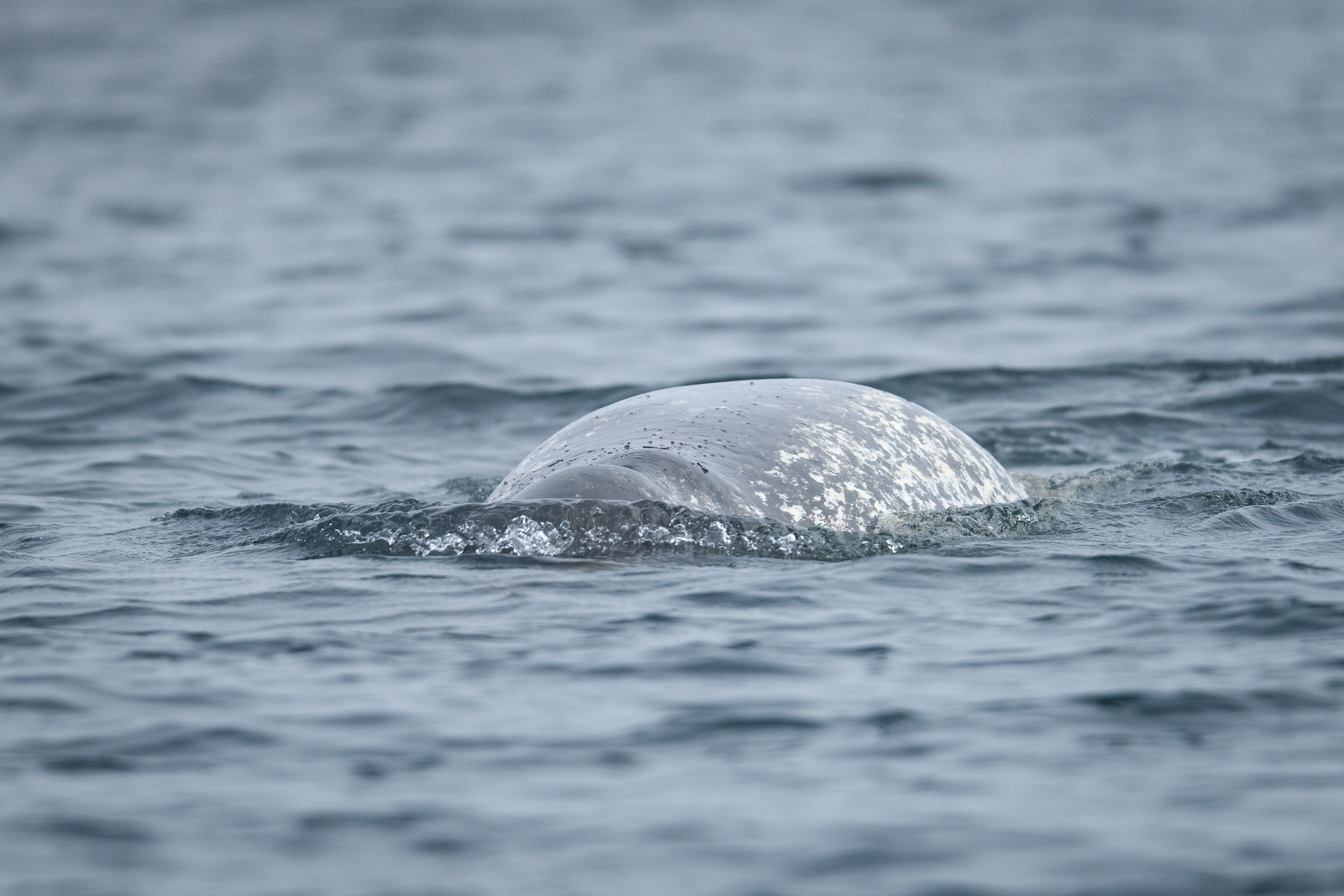
Narwhal © Daniel Giesbrecht
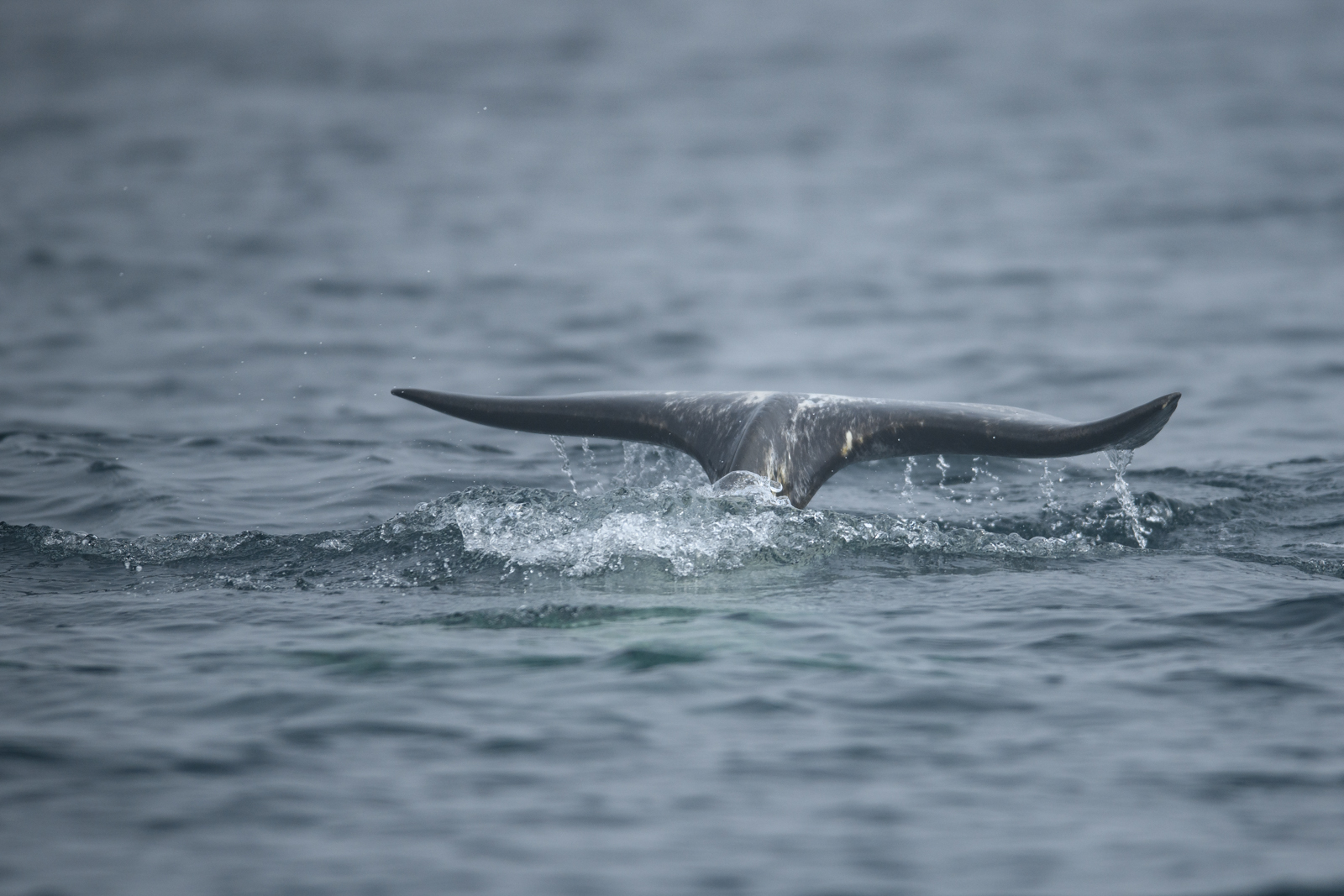
Narwhal fluke © Daniel Giesbrecht
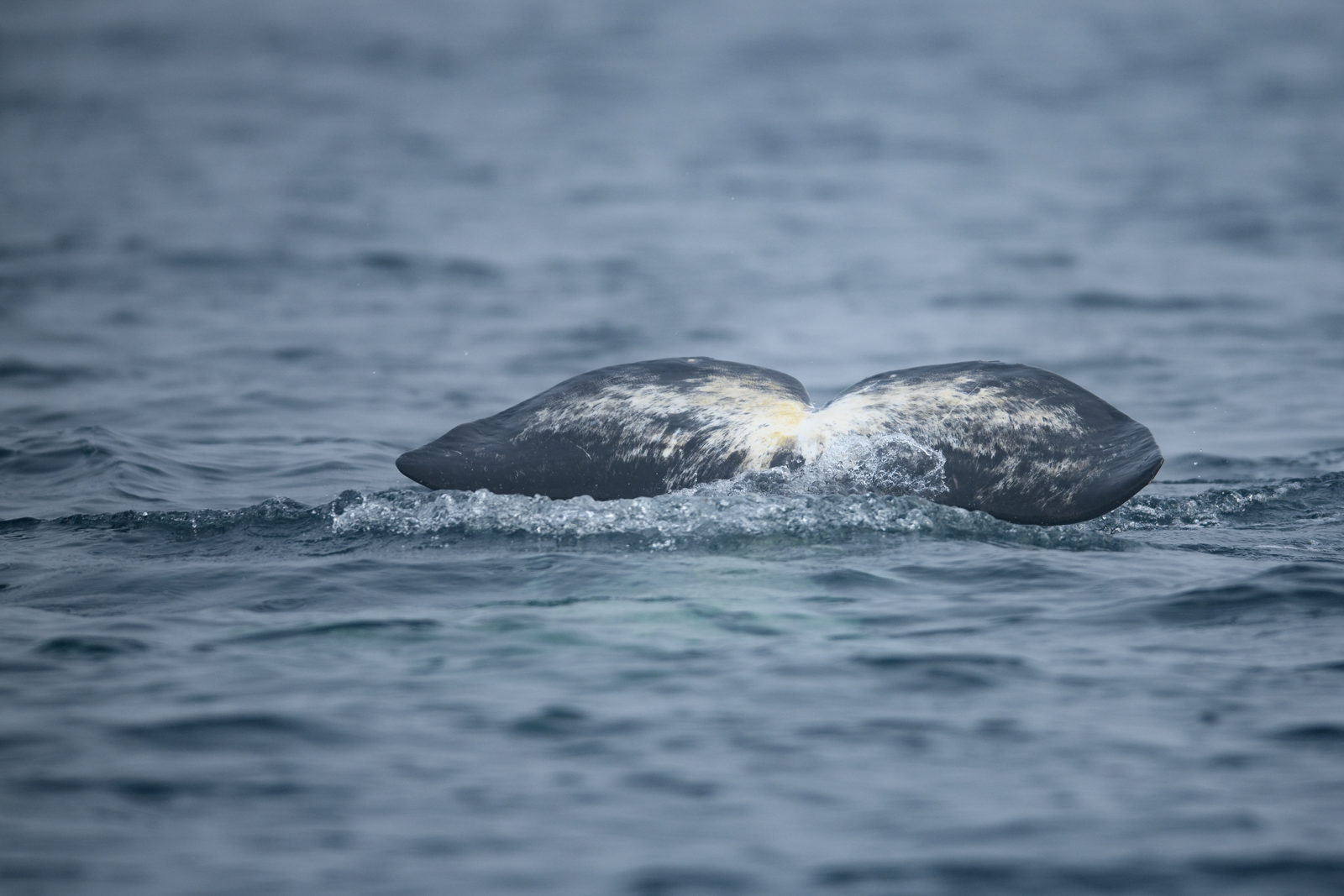
Narwhal fluke © Daniel Giesbrecht
Day 7: Last Full Day at the Floe Edge
Now a familiar sight, the fog once again greeted us in the morning. Though as we sipped on our coffee we began to notice it changing and hinting at lifting back into low clouds. This gave us an added spring to our step and we packed into the komatiks and headed back out to the Ocean’s edge. The fog had indeed been slowly lifting, and within a few hours we watched the almost unbelievable transition to a clear bright sunny day, with the fog pulling back to the shores of Bylott Island where we could see it off in the distance hanging over where we had left our camp behind.
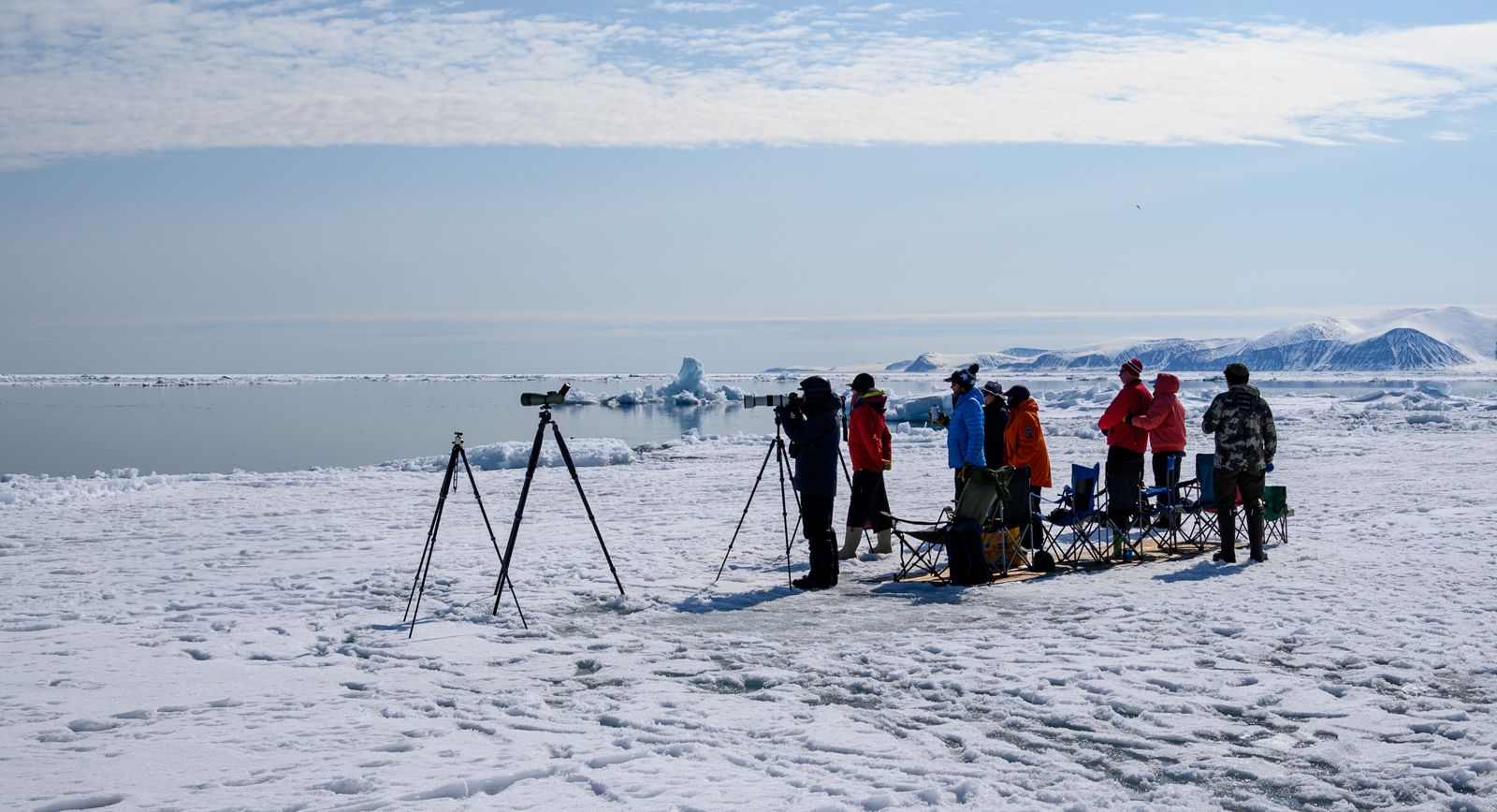
Floe Edge © Daniel Giesbrecht
The birds seemed about as happy with the transition as we were and were out in full force. Groups of Murres dotted the Floe Edge, with a smattering of Black Guillemots among them and Dovekis flying in tight groups further out to sea.
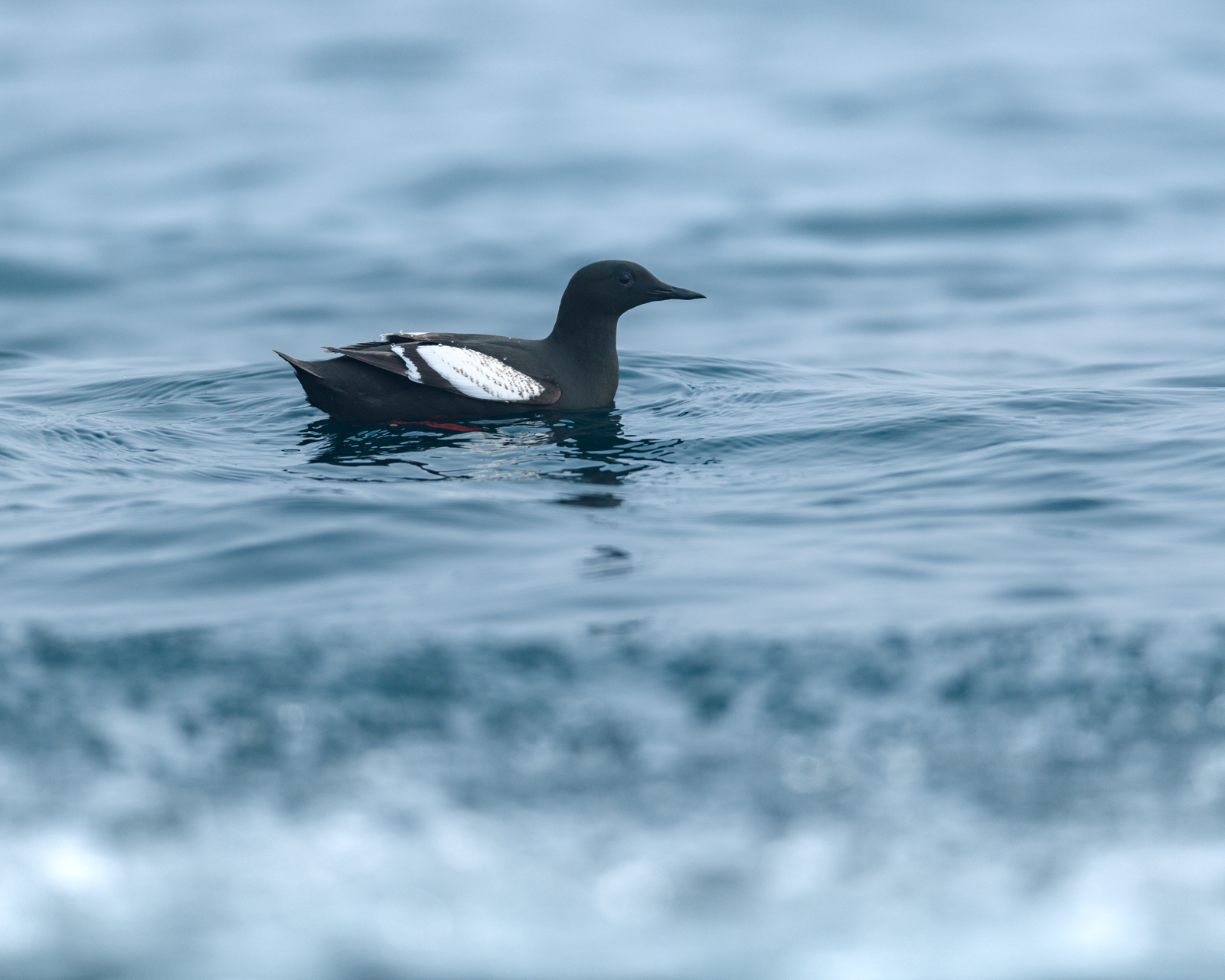
Black Guillemot © Daniel Giesbrecht
A small group of Arctic Terns landed out on an iceberg, and a few Sabine’s Gulls were out on the water bobbing up and down. At one point we heard a Bowhead Whale blow, and eventually caught a brief glimpse as it was quite far out among the floating ice. Amongst a group of gulls we were pleased to spot an adult plumaged Ivory Gull perched high on a piece of ice, which gave everyone a chance to get a good look. It is strictly an Arctic breeder, and they can be very difficult to find as they rarely if ever venture south of Northern Quebec and Newfoundland during the winter. Not an hour later we were surprised by a Ross Gull that flew directly overhead chasing a Kittiwake! This gulls range is even more restricted than the Ivory, only breeding in a few select locations in the High Arctic in Canada and along the Western Greenland coast, spending winters off the Northern coast of Alaska.
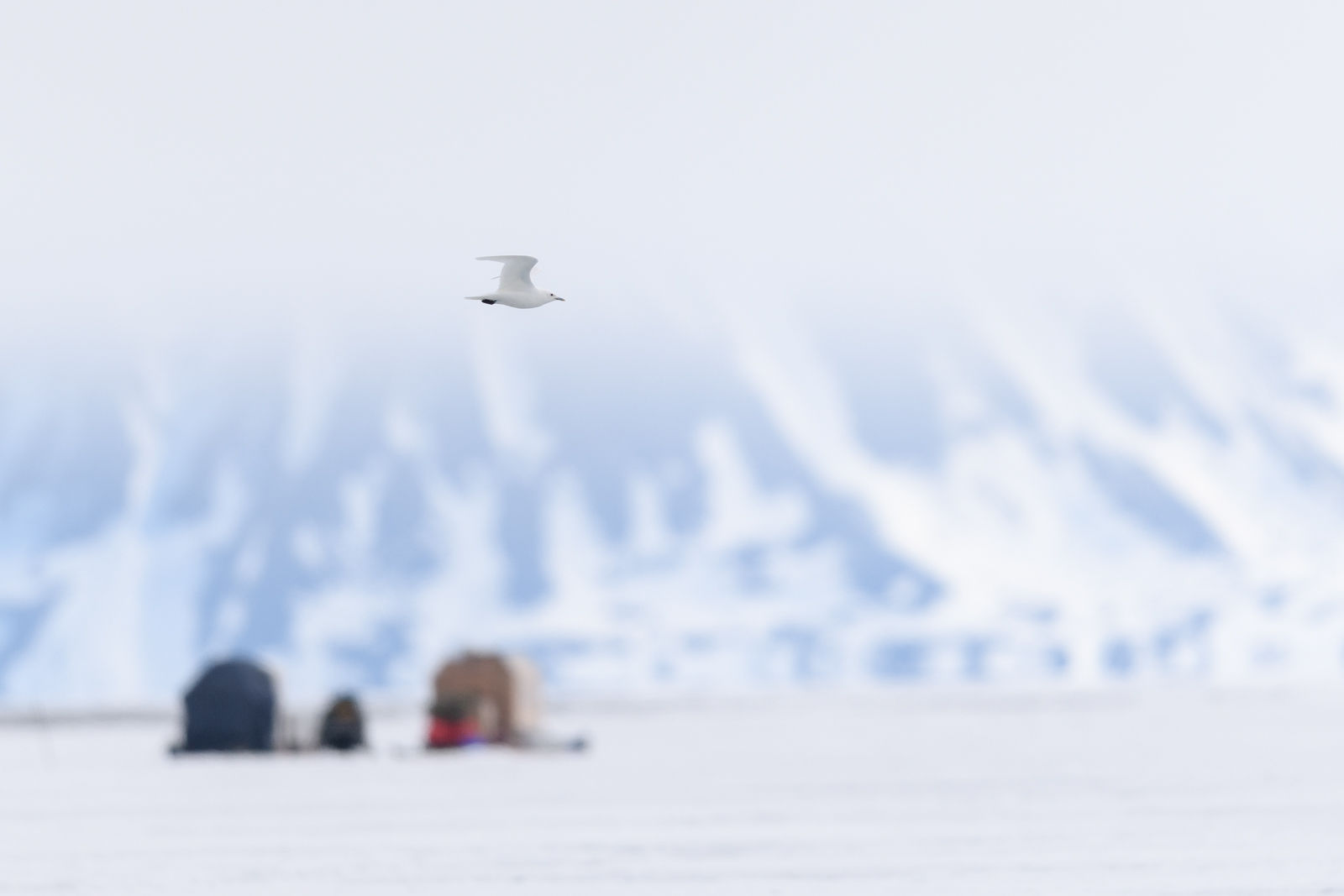
Ivory Gull against the lifting fog © Daniel Giesbrecht
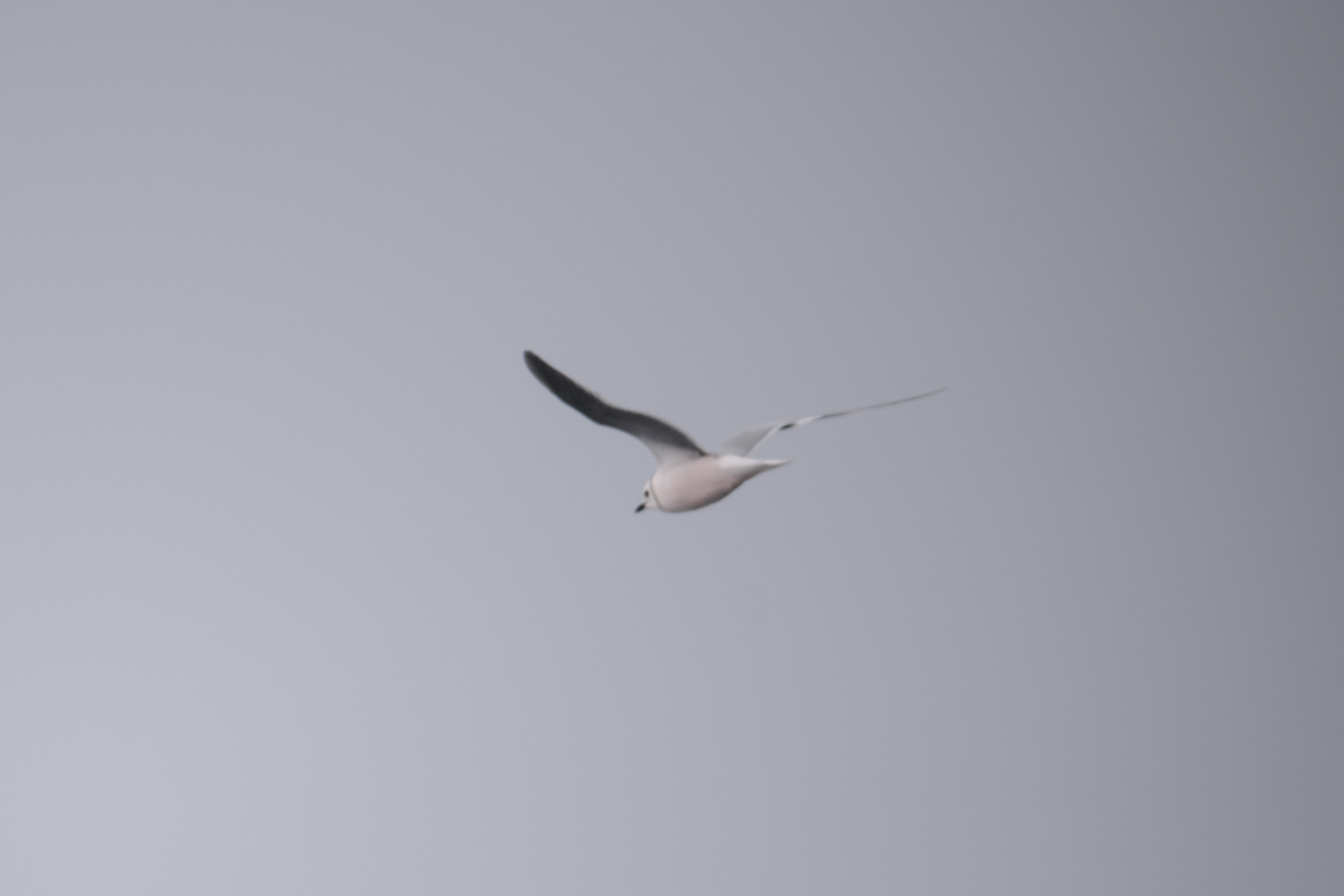
Ross’s Gull! © Daniel Giesbrecht
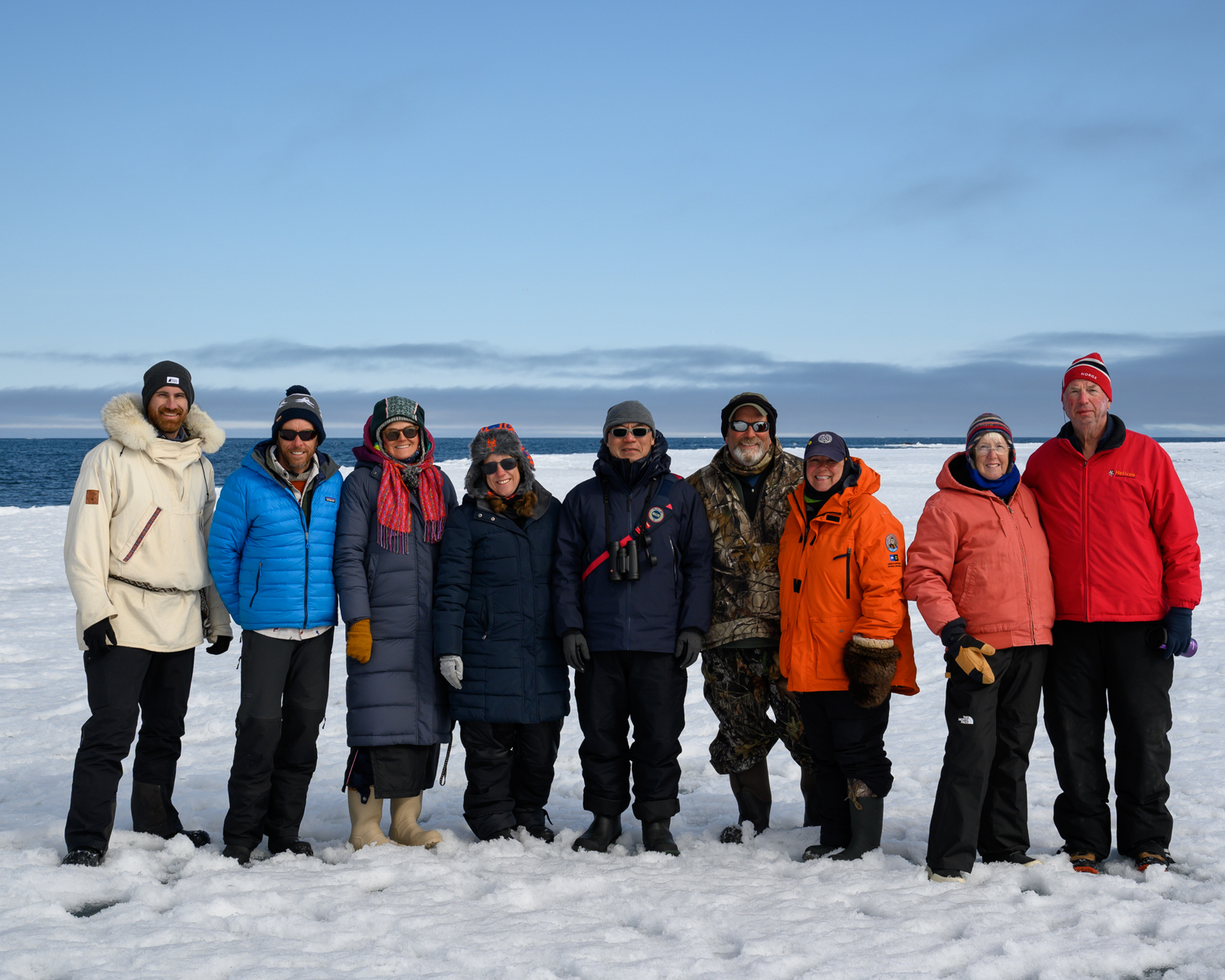
Our group
Day 8: Last Day at Camp and Return to Pond
Our last morning was mostly spent breaking down camp as Sheatie had received reports that the ice had been shifting and the leads back towards Pond Inlet were at risk of opening up. For this reason he was anxious about getting back as soon as possible, and we opted to not head back out to the Floe Edge. After breaking down our tents and packing personal items we had enough time to take a nice morning hike up the hillsides of Blyott Island. We ended up hiking up to around ~500ft elevation to a nice ridge overlooking the nearby river that had been our source of fresh water for the duration of our stay.
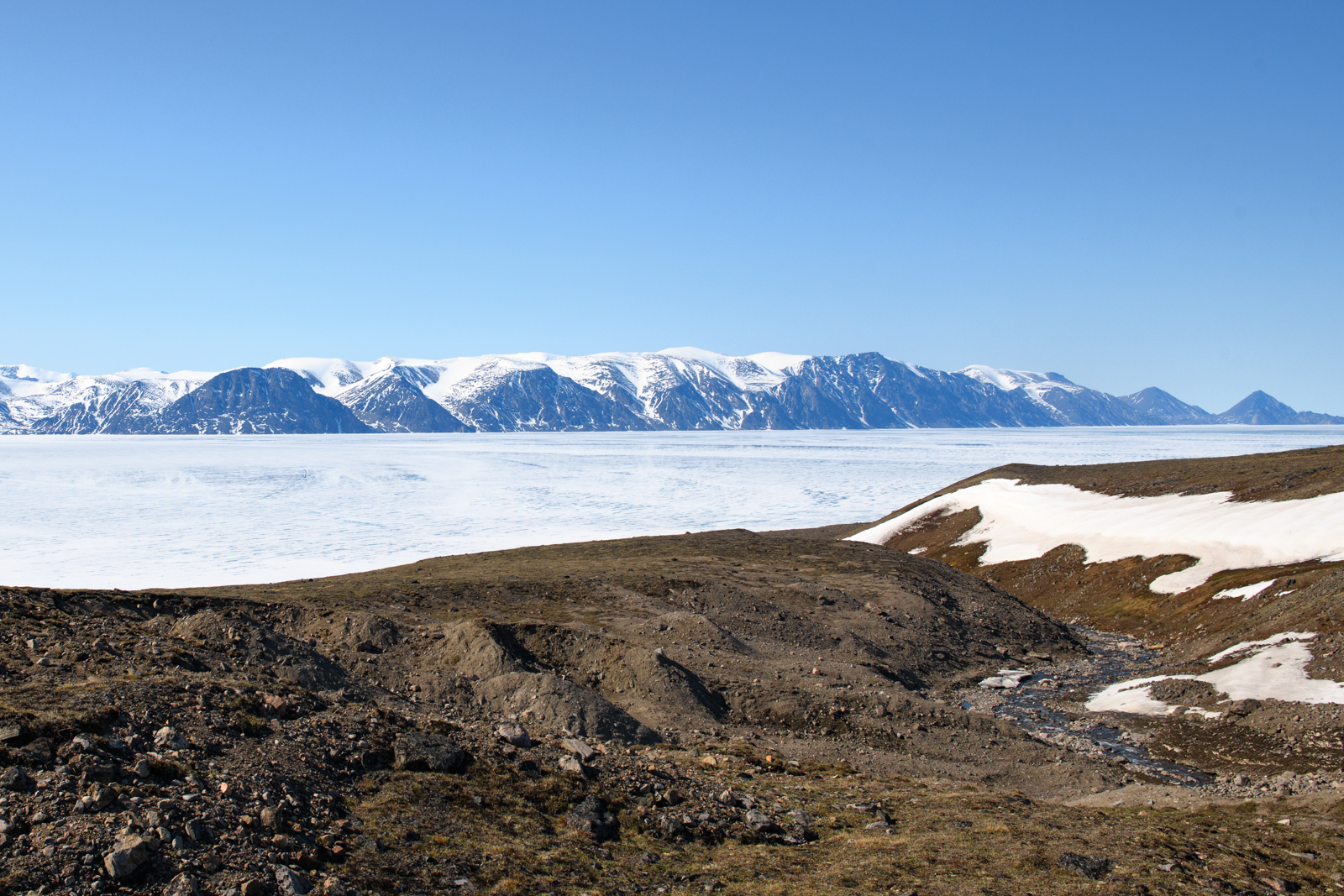
Hillside and stream by camp © Daniel Giesbrecht
Along the hillside we came across a Red Fox darting across the valley, and it paused on the snow just long enough to get a distant photo. There were also a few Bairds Sandpipers scattered around, along with some Lapland Longspurs and Snow Buntings that were already singing. It was a great way to end off the trip, as the view back behind us was completely open and unobstructed by fog or cloud, and we could make out the spots where we had been situated on the Floe Edge even though they were about 10 km from our location.
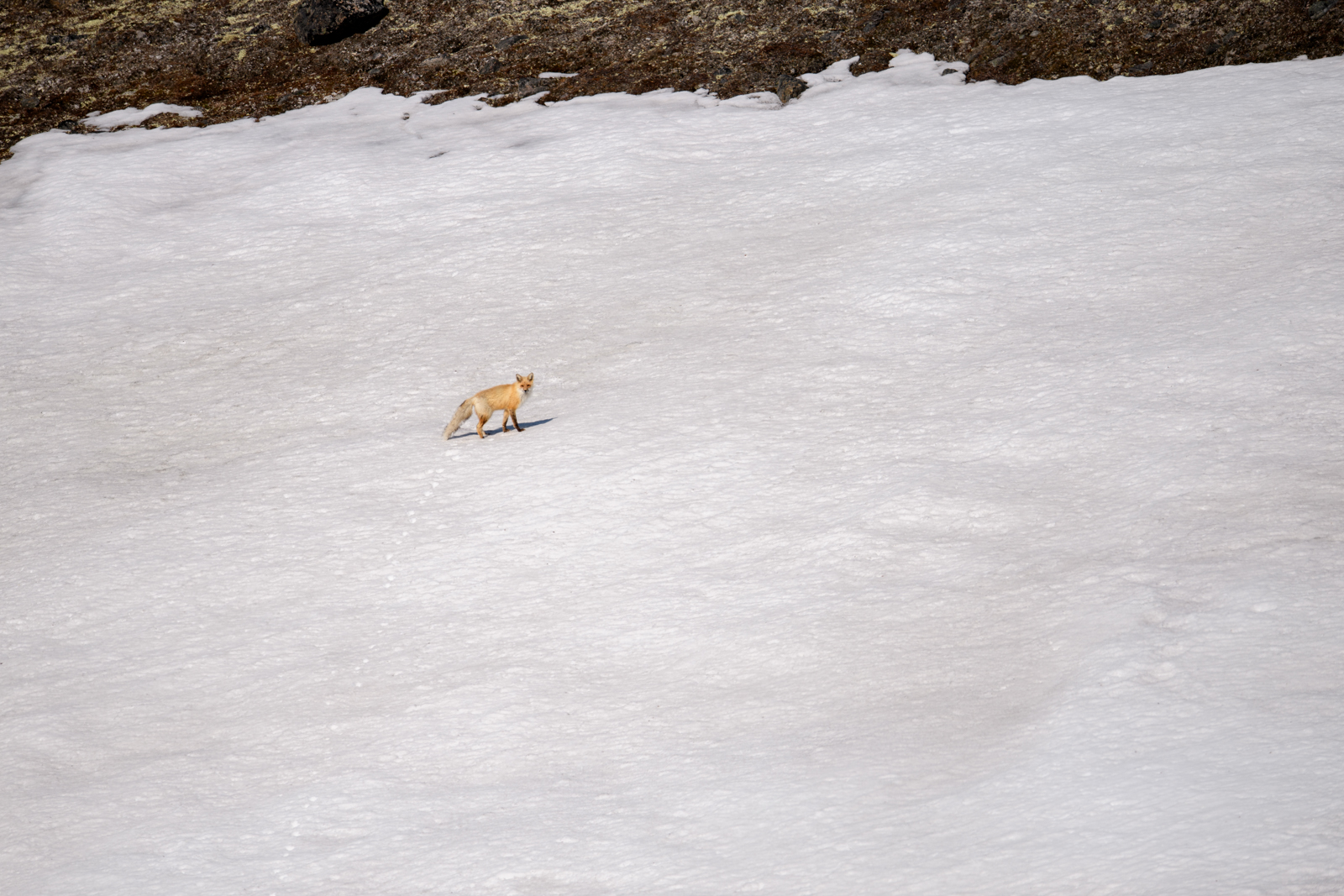
Red Fox © Daniel Giesbrecht
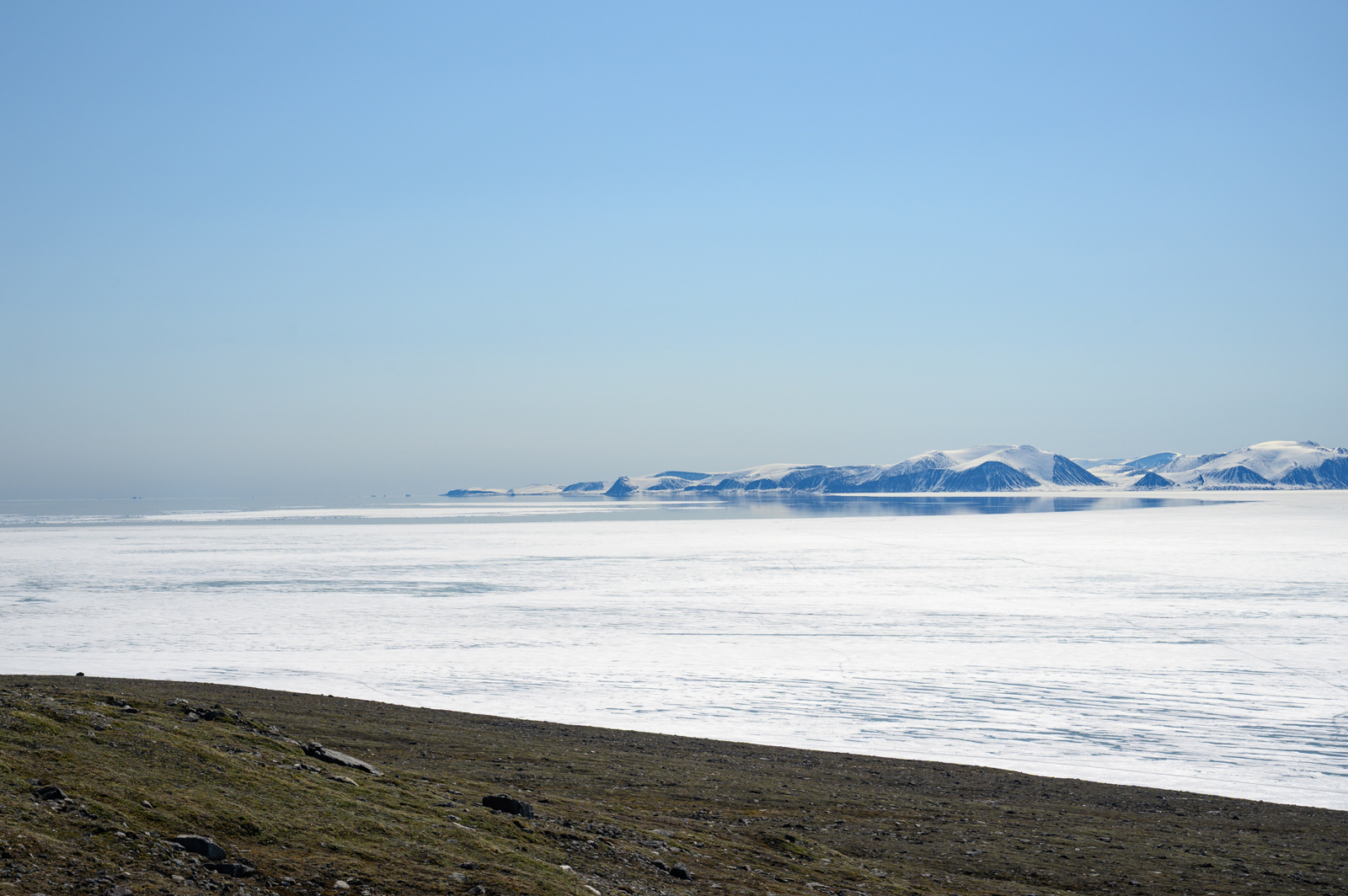
View of the Inlet © Daniel Giesbrecht
The afternoon was taken up by our long journey back along the ice, and though it was bittersweet to be leaving the camp site that had become our home over the past several days, the views to be had along the way were breathtaking enough to take up most of our attention.
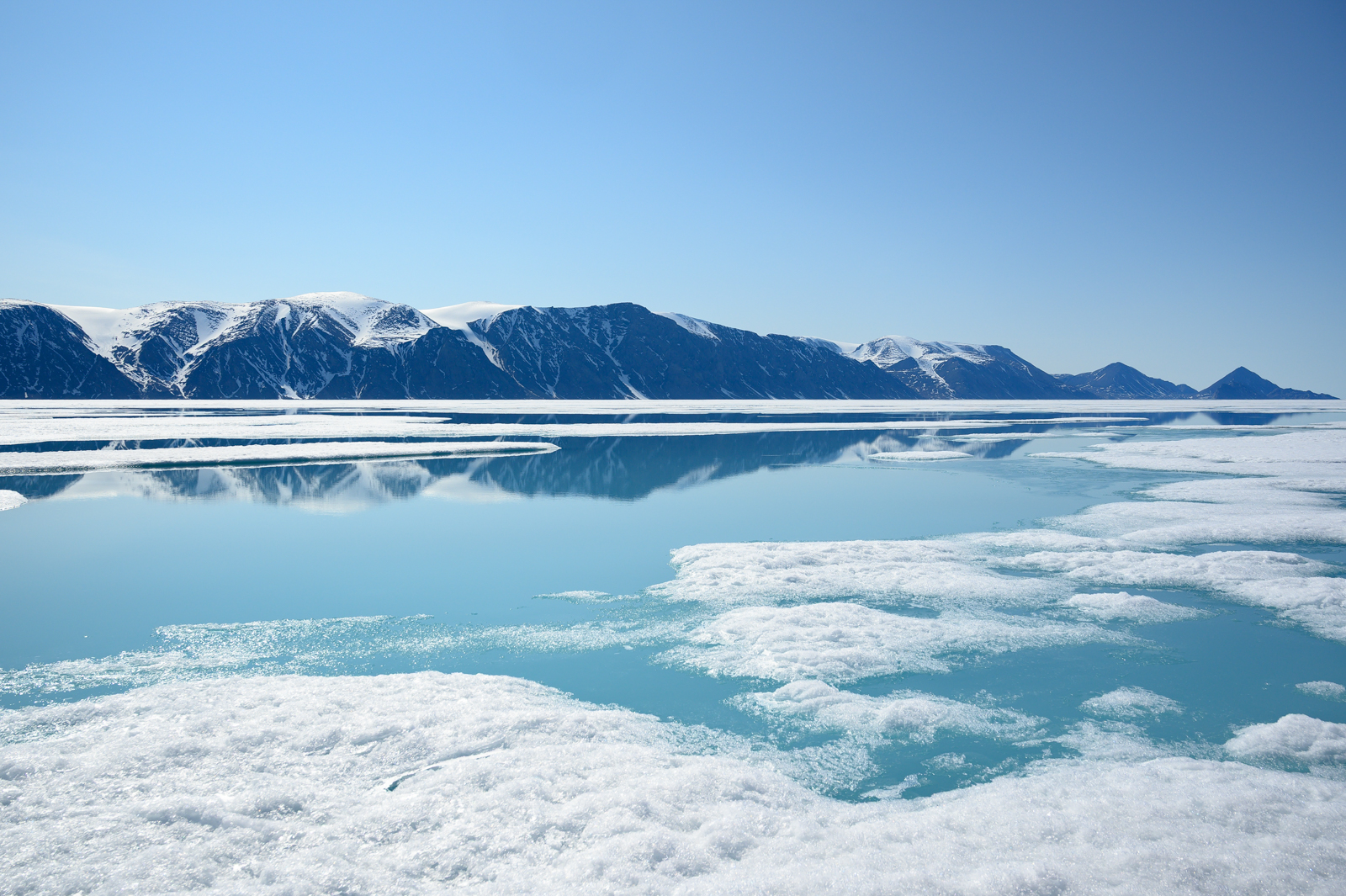
Meltwater Reflections © Daniel Giesbrecht
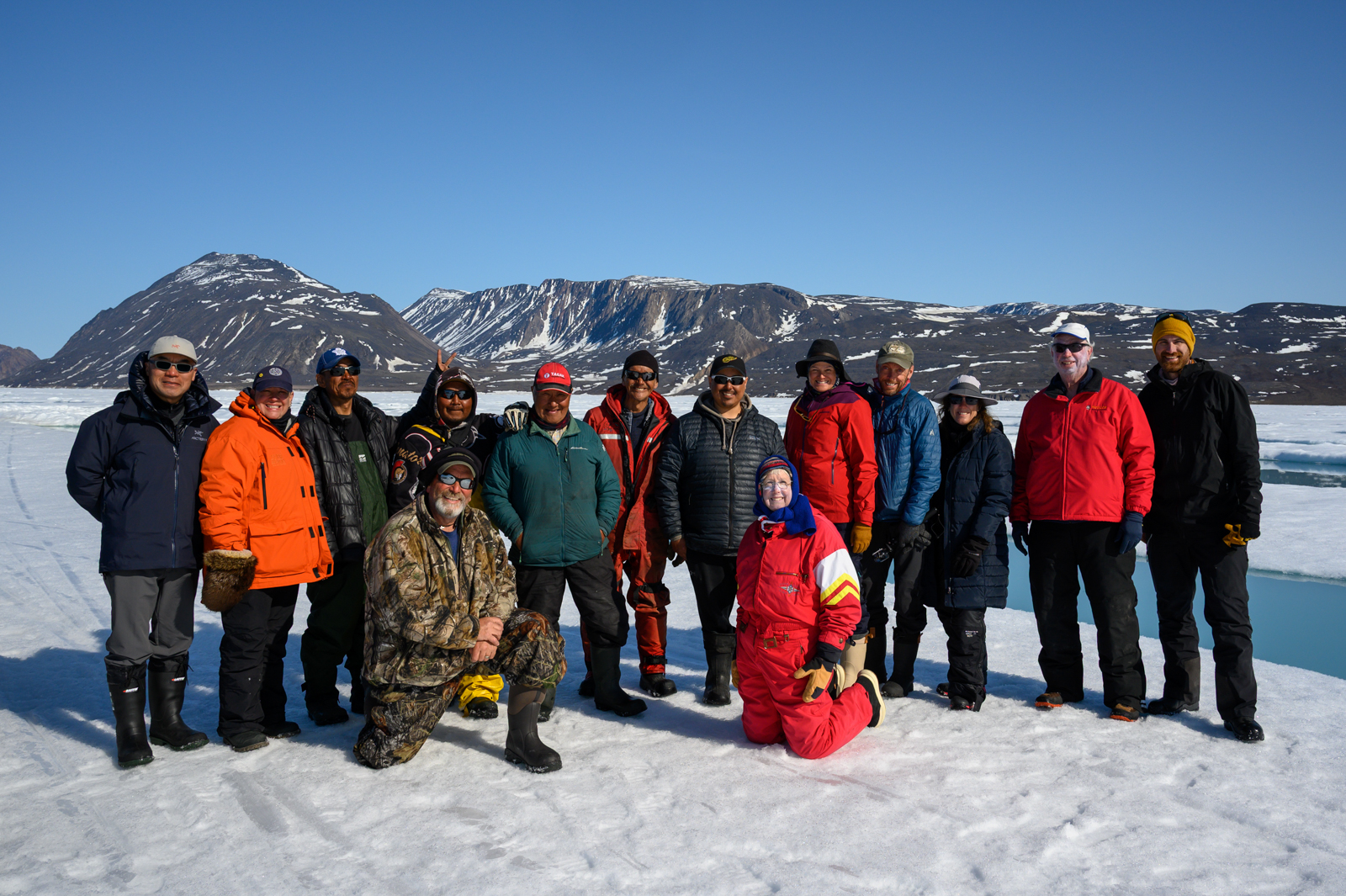
Our group and amazing crew
Day 9: Return Trip To OttawaOur last morning in Pond was spent exploring the town on another bright sunny and calm Arctic day. Everyone broke off into their own groups to get in as much sightseeing as possible, heading down to the docks for a last glimpse over the ice, up to the viewing platform, or back along the road to Salmon creek. The museum was supposed to be closed due to a local holiday, but a few of the group managed to catch a friendly staff member who graciously let them in.
After lunch we said our goodbyes to Sheatie and the guides who came to the airport to see us off. Upon takeoff there was nothing but open skies, and we had wonderful views of Baffin Island all the way to Iqaluit. Upon landing in Iqaluit we had just enough time to hail a cab and head down to a local gift store, which featured a large collection of sculptures and various art pieces from local Inuit artists. On our way back we decided it was close enough to cover on foot. Along the way we stopped by at a local café for one last coffee and a treat before continuing back to the airport.
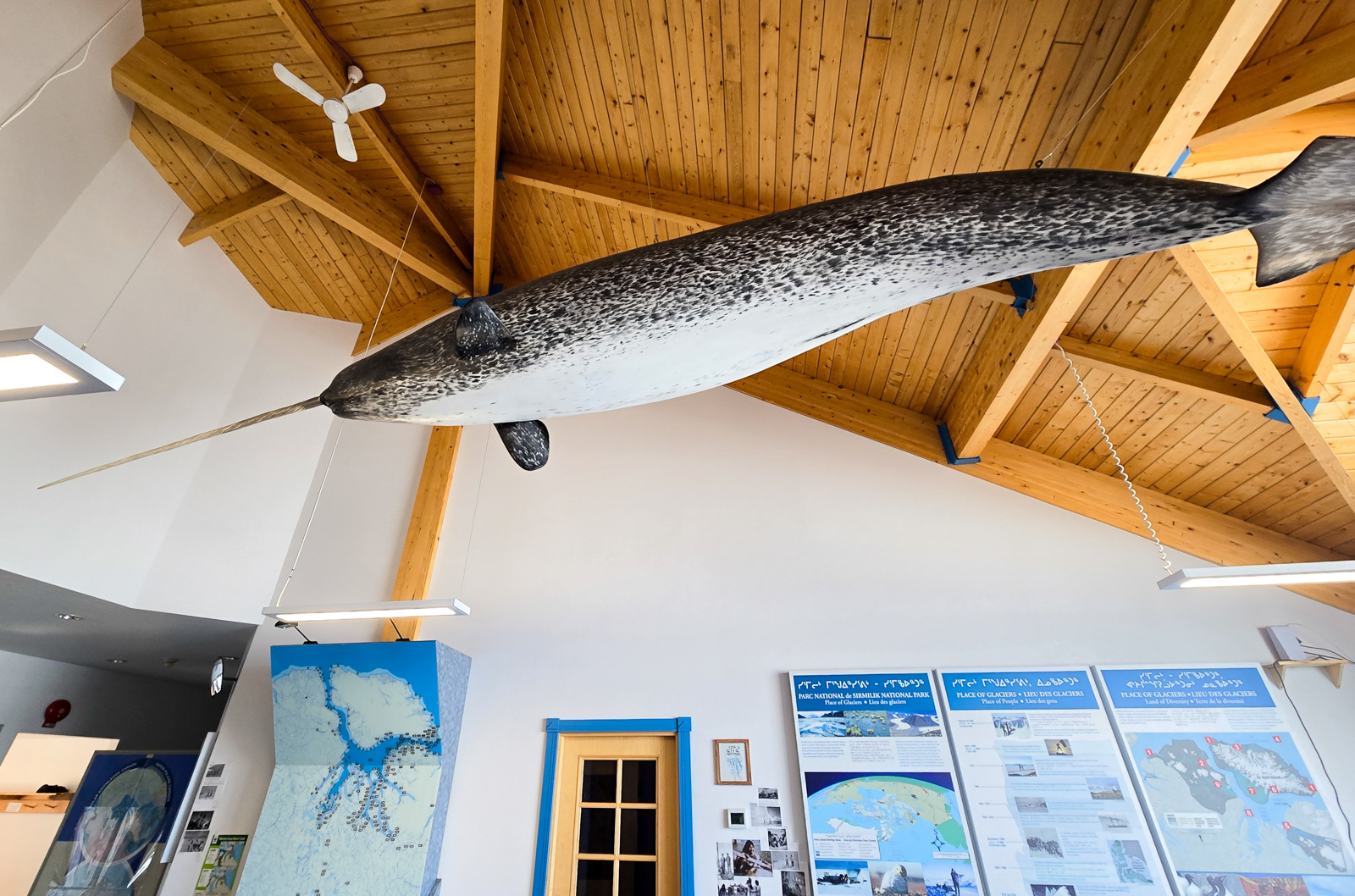
Museum Narwhal specimen © Christin Bentley




Leave a Reply